Part 3: Noël van Mierlo's Balancing Act - with carexTours
 As a member of Carolyn Mullet's Dutch Wave tour in August 2016, I joined a simpatico group of international garden travelers with a special interest in the work of Piet Oudolf and many practitioners of the garden design movement he largely founded ... the Dutch Wave, often called the New Perennial movement. The carexTours itinerary gave us an intense overview of Piet Oudolf's work and Dutch Wave design, as well as glimpses into work of several other major garden designers--including two gardens by one designer very atypical of the Dutch Wave, Noël van Mierlo, the subject of this post. Seeing the two van Mierlo gardens was a revelatory experience, making us think about what a garden is, and giving greater insight into the distinguishing characteristics of the Dutch Wave.For more information on future tours, just click on carexTours.
As a member of Carolyn Mullet's Dutch Wave tour in August 2016, I joined a simpatico group of international garden travelers with a special interest in the work of Piet Oudolf and many practitioners of the garden design movement he largely founded ... the Dutch Wave, often called the New Perennial movement. The carexTours itinerary gave us an intense overview of Piet Oudolf's work and Dutch Wave design, as well as glimpses into work of several other major garden designers--including two gardens by one designer very atypical of the Dutch Wave, Noël van Mierlo, the subject of this post. Seeing the two van Mierlo gardens was a revelatory experience, making us think about what a garden is, and giving greater insight into the distinguishing characteristics of the Dutch Wave.For more information on future tours, just click on carexTours. 
 I didn't know what to expect the morning we started out on our visit to two Noël van Mierlo gardens. My Dutch-American friend Carrie Preston, who has lived in The Netherlands for many years, had told me a bit about him, that his gardens has received several national awards ... but coming after a visit to Piet Oudolf's very different Vlinderhof only the day before, I certainly didn't expect the architectural, highly choreographed gardens we were to see. Van Mierlo's stunning gardens are a dramatic break from the Dutch Wave style that has been flourishing in The Netherlands for the past two decades.
I didn't know what to expect the morning we started out on our visit to two Noël van Mierlo gardens. My Dutch-American friend Carrie Preston, who has lived in The Netherlands for many years, had told me a bit about him, that his gardens has received several national awards ... but coming after a visit to Piet Oudolf's very different Vlinderhof only the day before, I certainly didn't expect the architectural, highly choreographed gardens we were to see. Van Mierlo's stunning gardens are a dramatic break from the Dutch Wave style that has been flourishing in The Netherlands for the past two decades.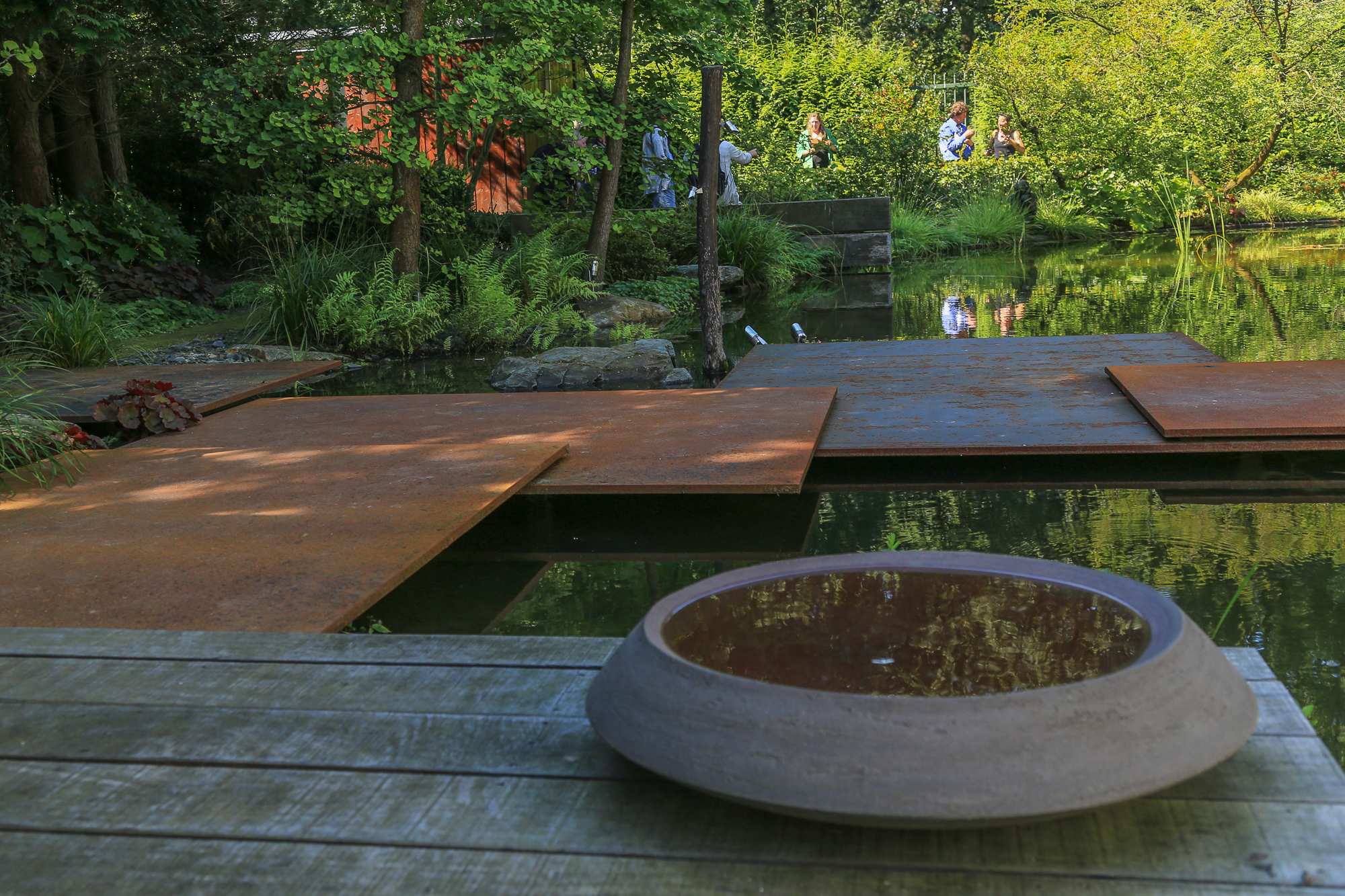 Why are van Mierlo's gardens so different? Dutch Wave gardens emulate the look of nature ... rather, they take their inspiration from the look of nature and intensify that look. They are about display of perennials and grasses, and an intensely emotional response to those plants, about the biological entities, the plants themselves, in all their glorious variety and multivariate forms through all seasons. They seem to work on some primal emotional level. Trees, structure, stone, water are not necessary, or even representative of the Dutch Wave--the focus is on the herbaceous perennials and grasses--though they may be present, and important parts of, individual gardens.Japanese Water GardenNoël van Mierlo's Japanese water garden, in marked contrast, is about structure, texture, line, shape, about complexity (a complexity made to look simple), not about an emotional response to plants. It is a cool, meditative garden, a garden for musing. (It is also very much a continuation of the house, a series of outdoor rooms well suited to private enjoyment or social occasions.)
Why are van Mierlo's gardens so different? Dutch Wave gardens emulate the look of nature ... rather, they take their inspiration from the look of nature and intensify that look. They are about display of perennials and grasses, and an intensely emotional response to those plants, about the biological entities, the plants themselves, in all their glorious variety and multivariate forms through all seasons. They seem to work on some primal emotional level. Trees, structure, stone, water are not necessary, or even representative of the Dutch Wave--the focus is on the herbaceous perennials and grasses--though they may be present, and important parts of, individual gardens.Japanese Water GardenNoël van Mierlo's Japanese water garden, in marked contrast, is about structure, texture, line, shape, about complexity (a complexity made to look simple), not about an emotional response to plants. It is a cool, meditative garden, a garden for musing. (It is also very much a continuation of the house, a series of outdoor rooms well suited to private enjoyment or social occasions.)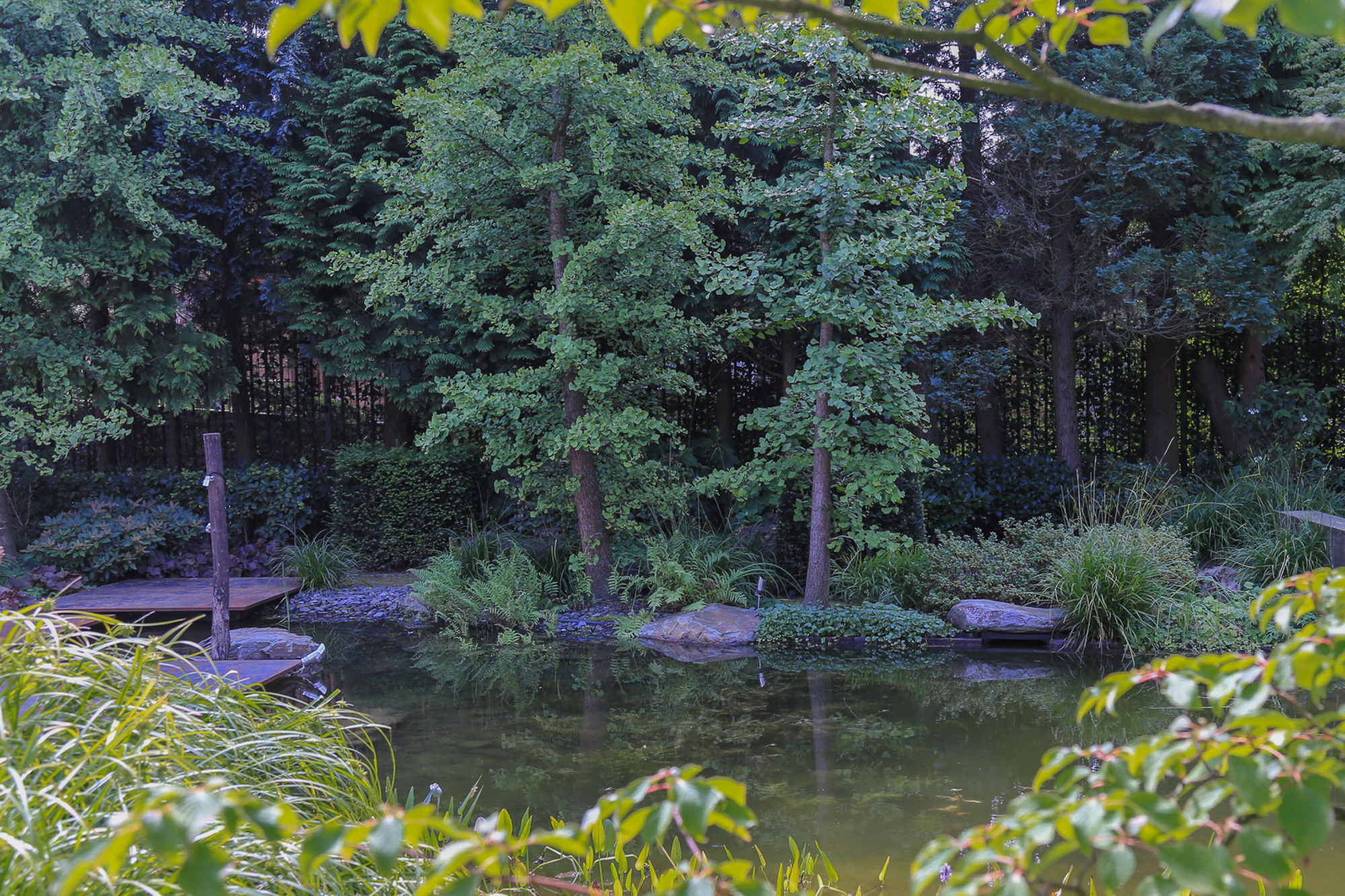 The garden is quiet, contemplative, observant of small details, almost opposite to the delight, exhilaration, and high-pitch of feelings often evoked by Dutch Wave plantings. It subtly juxtaposes natural and manmade morphologies to create a unified experience.
The garden is quiet, contemplative, observant of small details, almost opposite to the delight, exhilaration, and high-pitch of feelings often evoked by Dutch Wave plantings. It subtly juxtaposes natural and manmade morphologies to create a unified experience.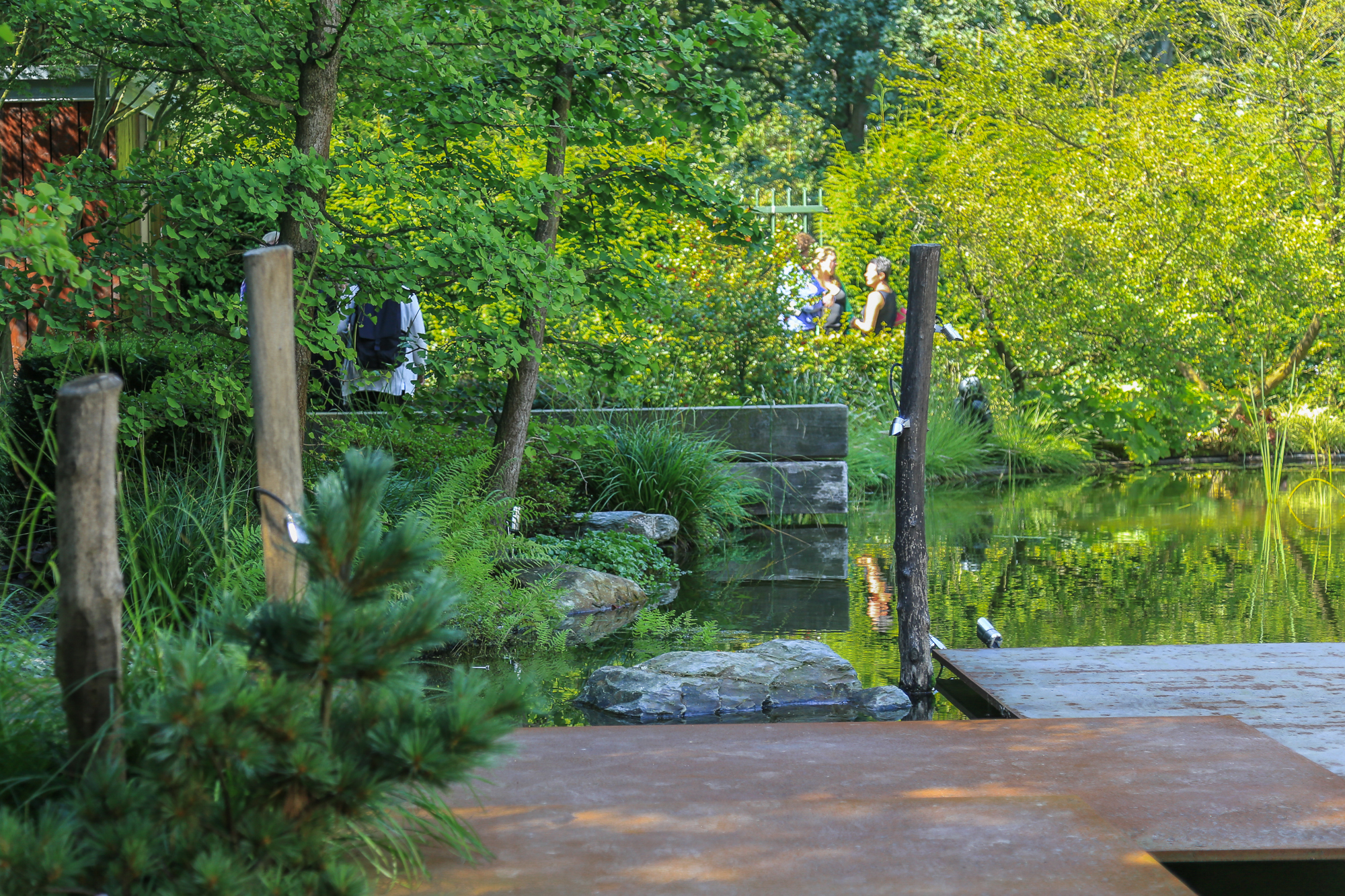 Architectural GardenVan Mierlo conceives the garden as a series of rooms and frequently refers to its floor, walls, ceiling. When I asked him for names of designers he admires, he mentioned Lake Flato and Tom Kundig--both architects--architects known for designing structures that sit easily in a natural, often wild, landscape, and for artfully crafted structures. You see architecture in the impressive use of the huge wooden bollards that form the entrance portal, in the refined lines of the modernist, yet sensuous, tea house, in the carefully selected and positioned rocks used to anchor the garden in the landscape, in the sensitive selection of trees with great character (trees too are part of the architecture of this garden) ...
Architectural GardenVan Mierlo conceives the garden as a series of rooms and frequently refers to its floor, walls, ceiling. When I asked him for names of designers he admires, he mentioned Lake Flato and Tom Kundig--both architects--architects known for designing structures that sit easily in a natural, often wild, landscape, and for artfully crafted structures. You see architecture in the impressive use of the huge wooden bollards that form the entrance portal, in the refined lines of the modernist, yet sensuous, tea house, in the carefully selected and positioned rocks used to anchor the garden in the landscape, in the sensitive selection of trees with great character (trees too are part of the architecture of this garden) ...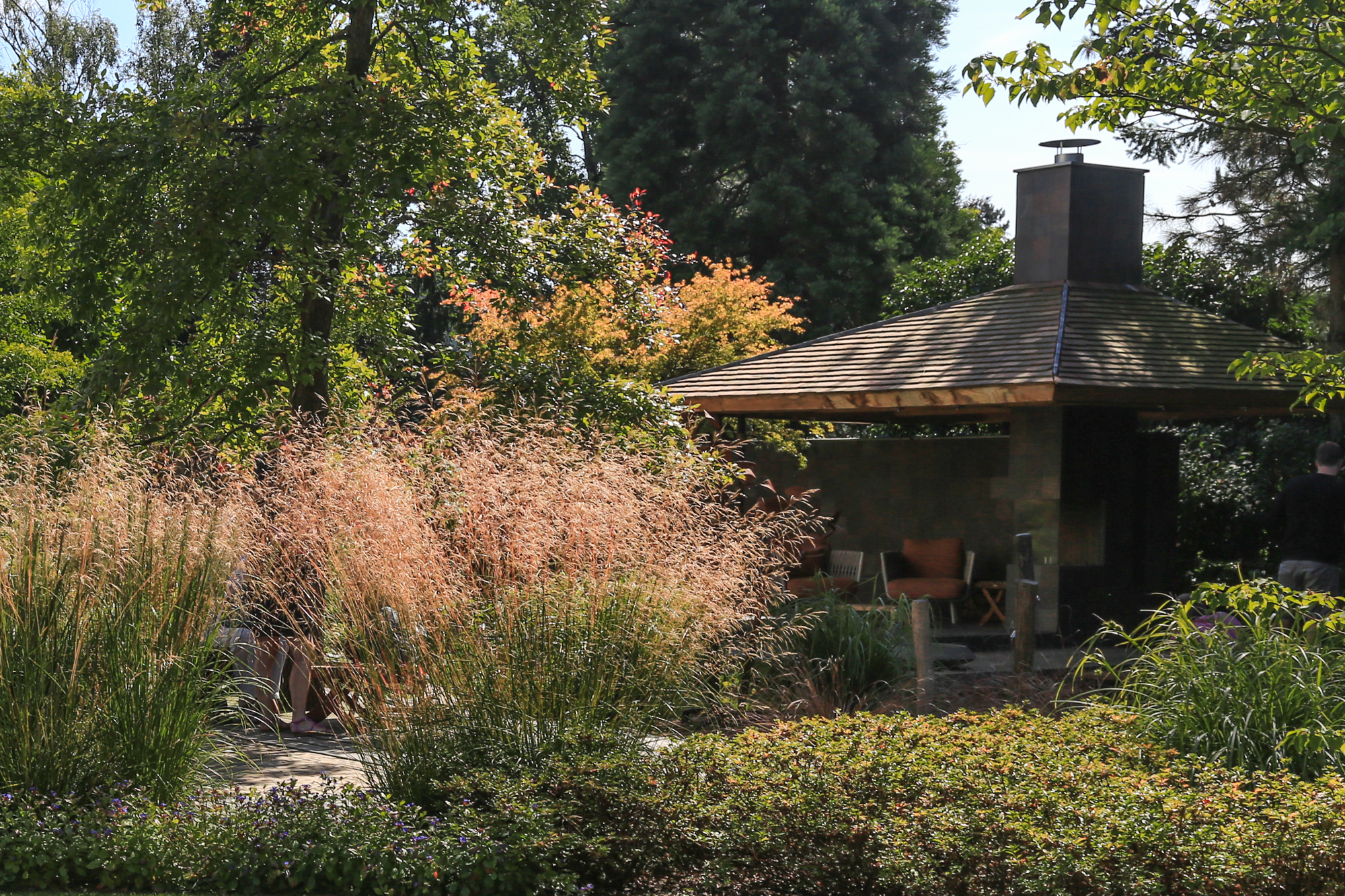 ...in the thick steel plates that gracefully bridge the pond, appearing to be suspended just above the water's surface (quite a structural engineering challenge), designed in collaboration with noted Dutch metal artist Xander Spronken ...
...in the thick steel plates that gracefully bridge the pond, appearing to be suspended just above the water's surface (quite a structural engineering challenge), designed in collaboration with noted Dutch metal artist Xander Spronken ...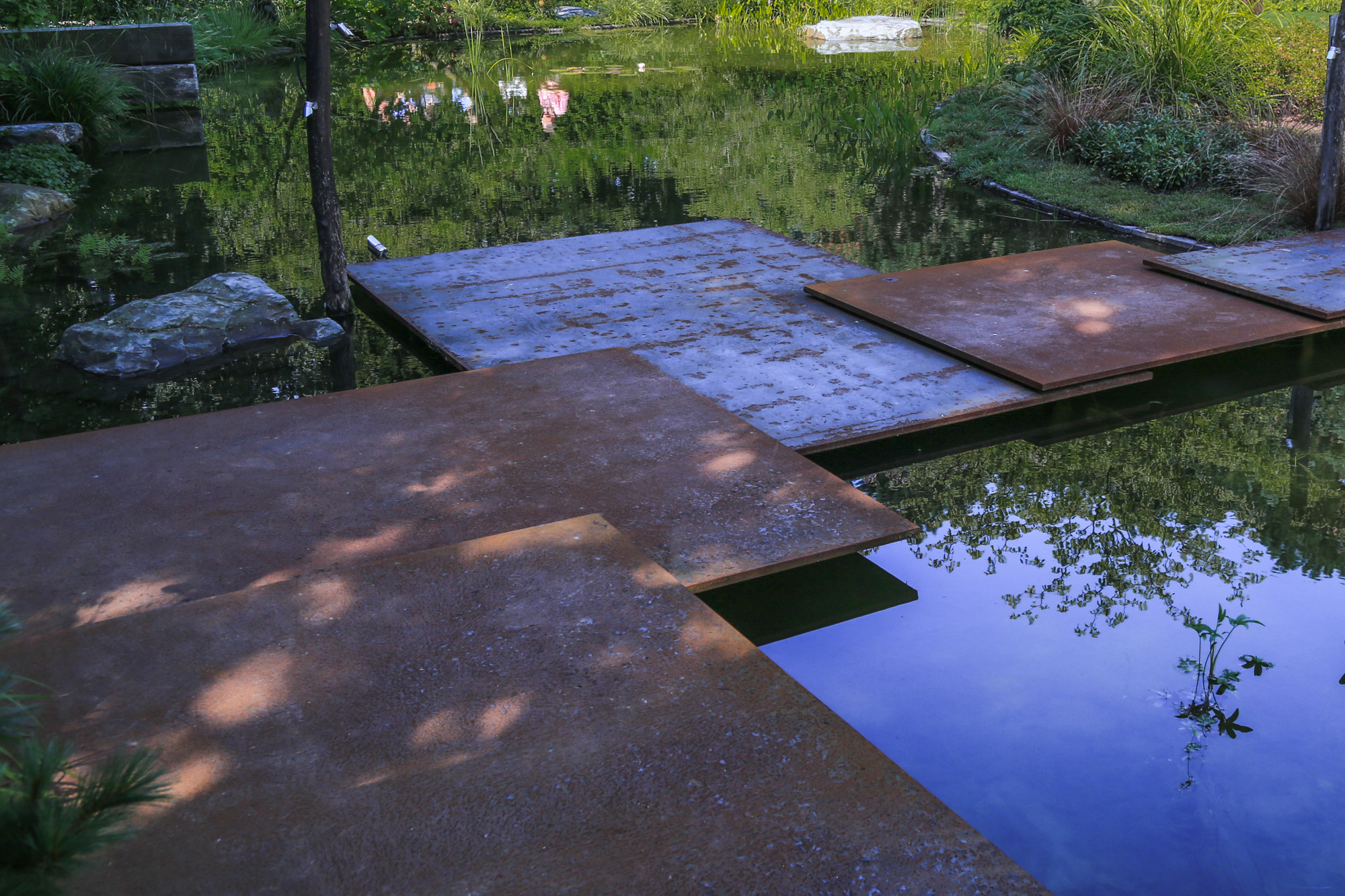 ... and in attention to appropriateness of materials and to the smallest details, as in this carefully crafted transition from gravel to lawn.
... and in attention to appropriateness of materials and to the smallest details, as in this carefully crafted transition from gravel to lawn.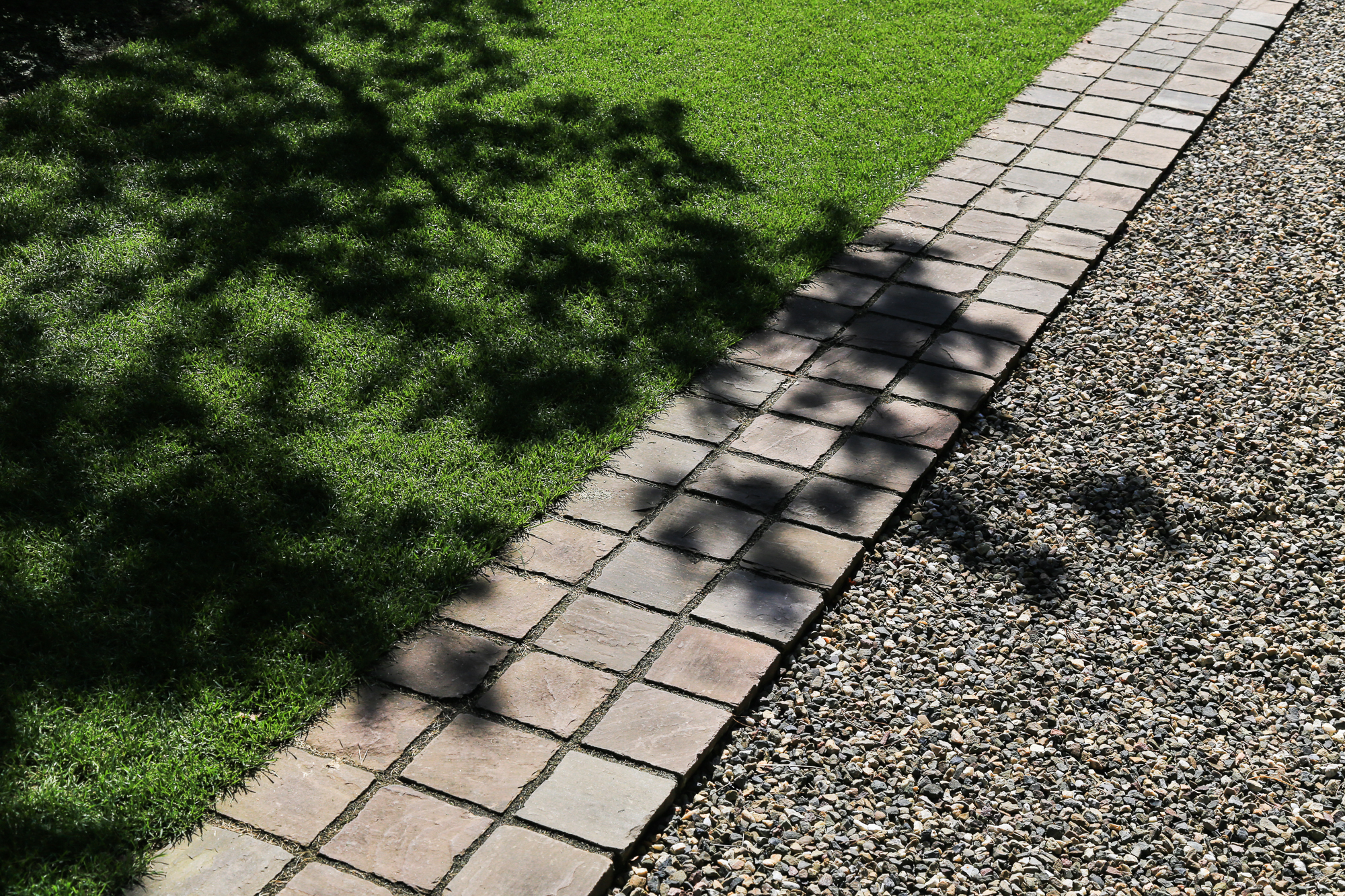 All through the design and construction process, he strives to find and use the finest craftsmen available for garden pavements, finishes, lighting--and planting.
All through the design and construction process, he strives to find and use the finest craftsmen available for garden pavements, finishes, lighting--and planting. Because this garden is a dramatic departure from plant-centric Dutch Wave gardens, it was a powerful reminder to those of us on Carolyn Mullet's Dutch Wave tour that gardens take many, and vastly different, forms.
Because this garden is a dramatic departure from plant-centric Dutch Wave gardens, it was a powerful reminder to those of us on Carolyn Mullet's Dutch Wave tour that gardens take many, and vastly different, forms. So did carexTours add the van Mierlo gardens as a "palate cleanser," perhaps, served between courses of Dutch Wave gardens? I don't think so. Carolyn wanted to make us think.Strangely, although it is certainly an architectural garden, full of complicated structural challenges, a garden difficult and costly to create, requiring heavy equipment, expensive materials, and precision in construction ...
So did carexTours add the van Mierlo gardens as a "palate cleanser," perhaps, served between courses of Dutch Wave gardens? I don't think so. Carolyn wanted to make us think.Strangely, although it is certainly an architectural garden, full of complicated structural challenges, a garden difficult and costly to create, requiring heavy equipment, expensive materials, and precision in construction ...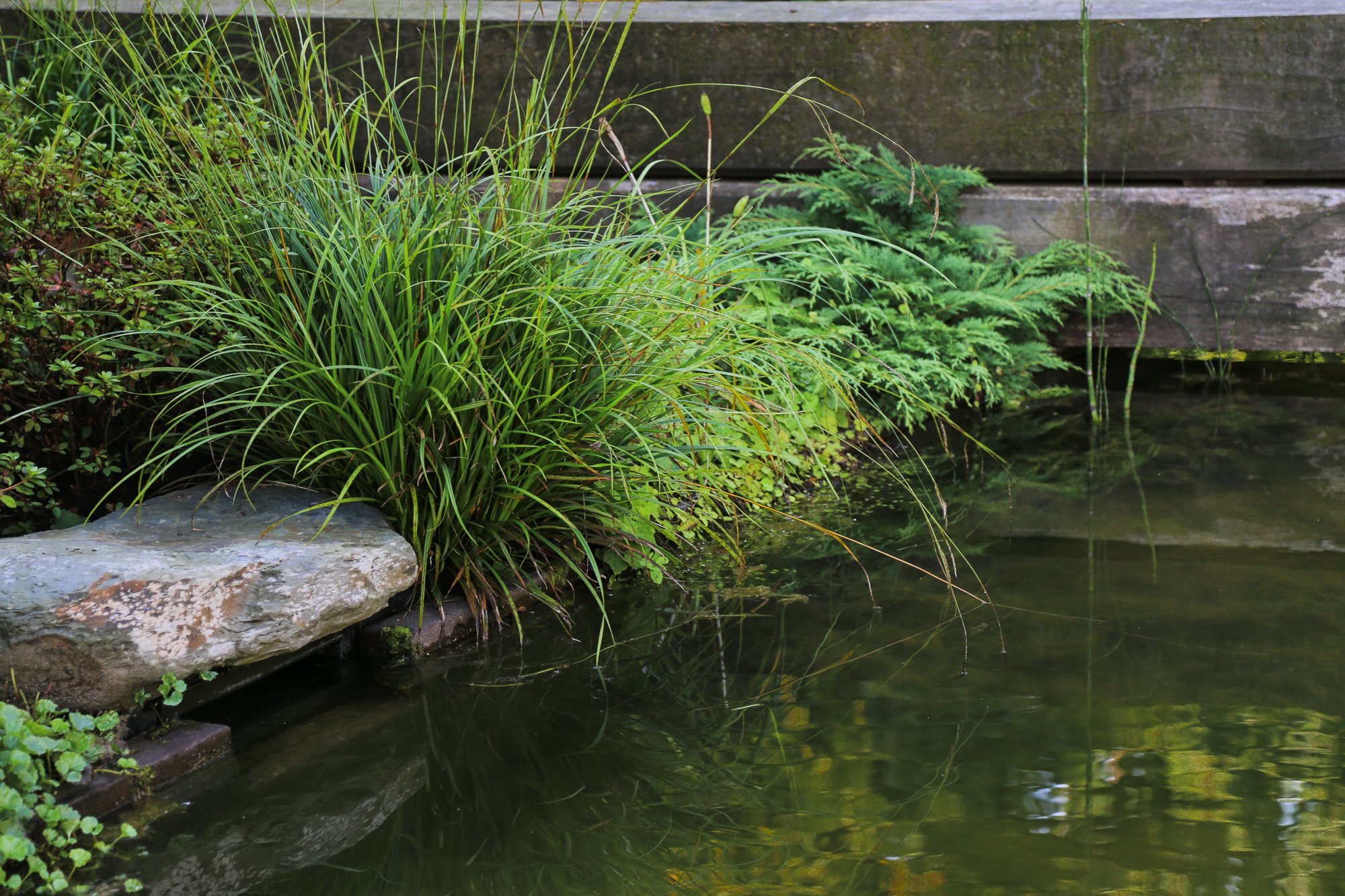 ... it is a garden about ecology, far more so than most Dutch Wave gardens are ... a garden that, in fact, creates habitat.
... it is a garden about ecology, far more so than most Dutch Wave gardens are ... a garden that, in fact, creates habitat. Opportunities for Novel EcologiesAmong its many other attributes, this is a garden for a connoisseur of plants and ecological design though, ironically, van Mierlo does not select the perennials in his gardens. That's not really such a strange concept if you compare garden making to other art forms. Think of him as the director of a theatrical performance or a film. He is the artist, the director, as well as the curator of expertise, and he has a talent for working with others. As with all garden challenges--architectural, structural, construction, Van Mierlo knows and uses experts and highly skilled craftsmen. In this case, his expert is an extremely talented plantsman, Ruurd van Donkelaar. (Van Mierlo does take a direct role in selection and placement of distinctive trees, the "walls" of the garden and the pillars holding up the sky, the ceiling of the garden.)
Opportunities for Novel EcologiesAmong its many other attributes, this is a garden for a connoisseur of plants and ecological design though, ironically, van Mierlo does not select the perennials in his gardens. That's not really such a strange concept if you compare garden making to other art forms. Think of him as the director of a theatrical performance or a film. He is the artist, the director, as well as the curator of expertise, and he has a talent for working with others. As with all garden challenges--architectural, structural, construction, Van Mierlo knows and uses experts and highly skilled craftsmen. In this case, his expert is an extremely talented plantsman, Ruurd van Donkelaar. (Van Mierlo does take a direct role in selection and placement of distinctive trees, the "walls" of the garden and the pillars holding up the sky, the ceiling of the garden.) Look at the care van Donkelaar used in designing this water's edge habitat. The rocks, gravel and plants are composed to create a "natural" transition from the water to the land, with a finely graduated differentiation of novel habitats to cover the pond liner and create a natural-looking transition, over a distance of only about three feet, of plants selected for suitability to their positions in water or on the drier edges; note the attention to scale in the planting, with miniature plants growing even between the small pieces of gravel. The design is elegant, restrained, possibly more natural than natural (a "created natural").
Look at the care van Donkelaar used in designing this water's edge habitat. The rocks, gravel and plants are composed to create a "natural" transition from the water to the land, with a finely graduated differentiation of novel habitats to cover the pond liner and create a natural-looking transition, over a distance of only about three feet, of plants selected for suitability to their positions in water or on the drier edges; note the attention to scale in the planting, with miniature plants growing even between the small pieces of gravel. The design is elegant, restrained, possibly more natural than natural (a "created natural").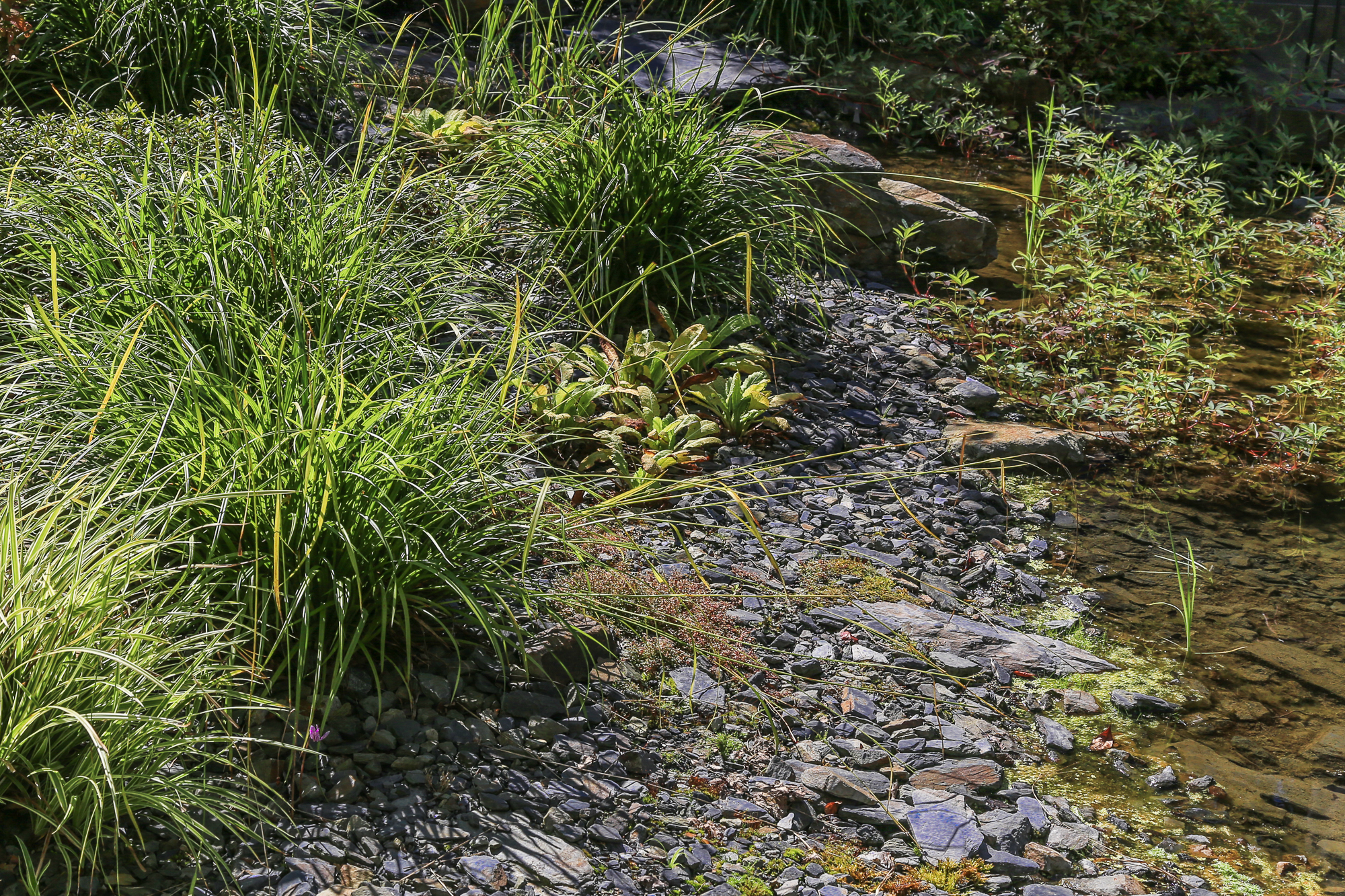 Only compare this to the crude transition below, one I recently photographed elsewhere ...
Only compare this to the crude transition below, one I recently photographed elsewhere ...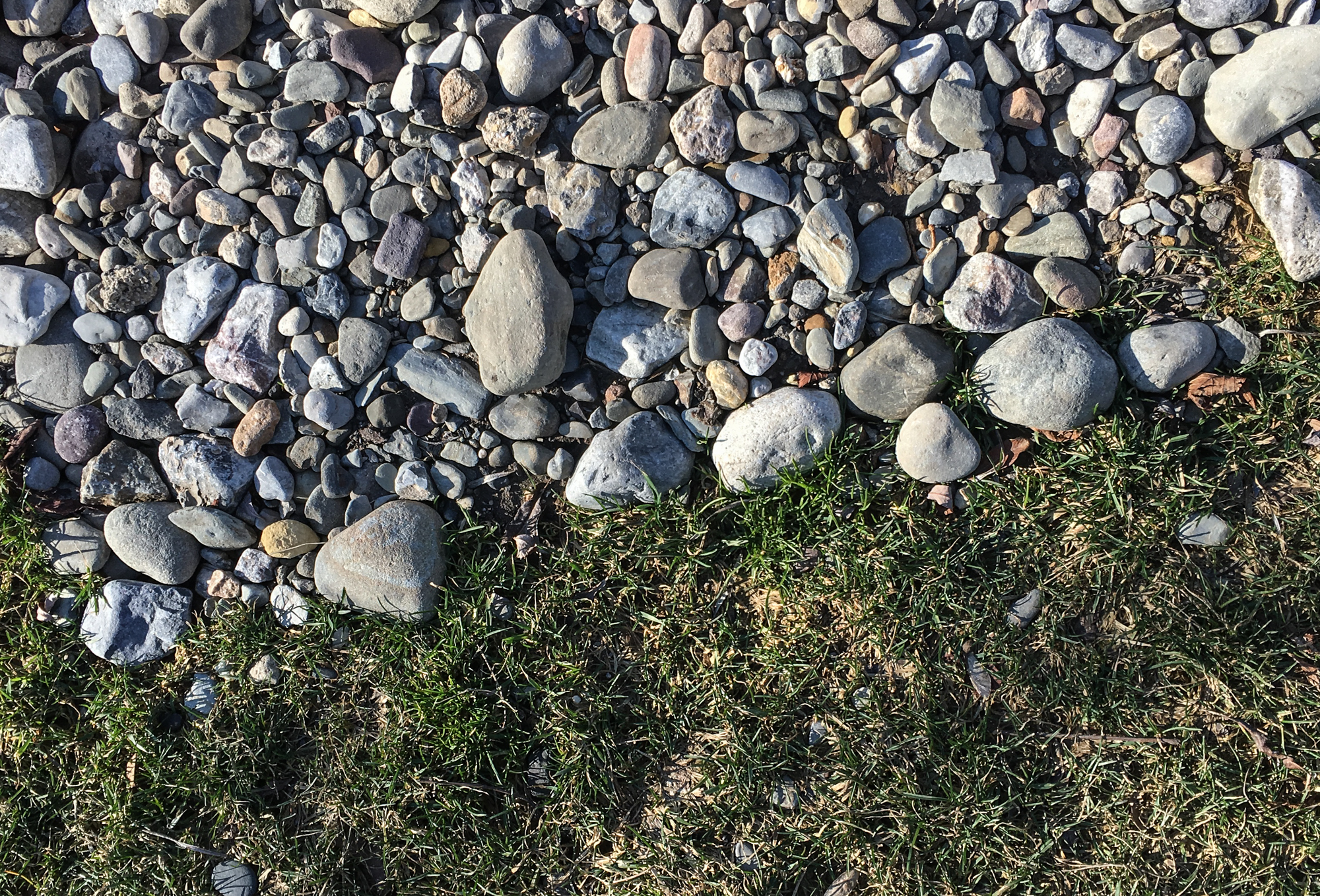 ... which, I think, makes the artfulness of the van Mierlo garden clear.
... which, I think, makes the artfulness of the van Mierlo garden clear.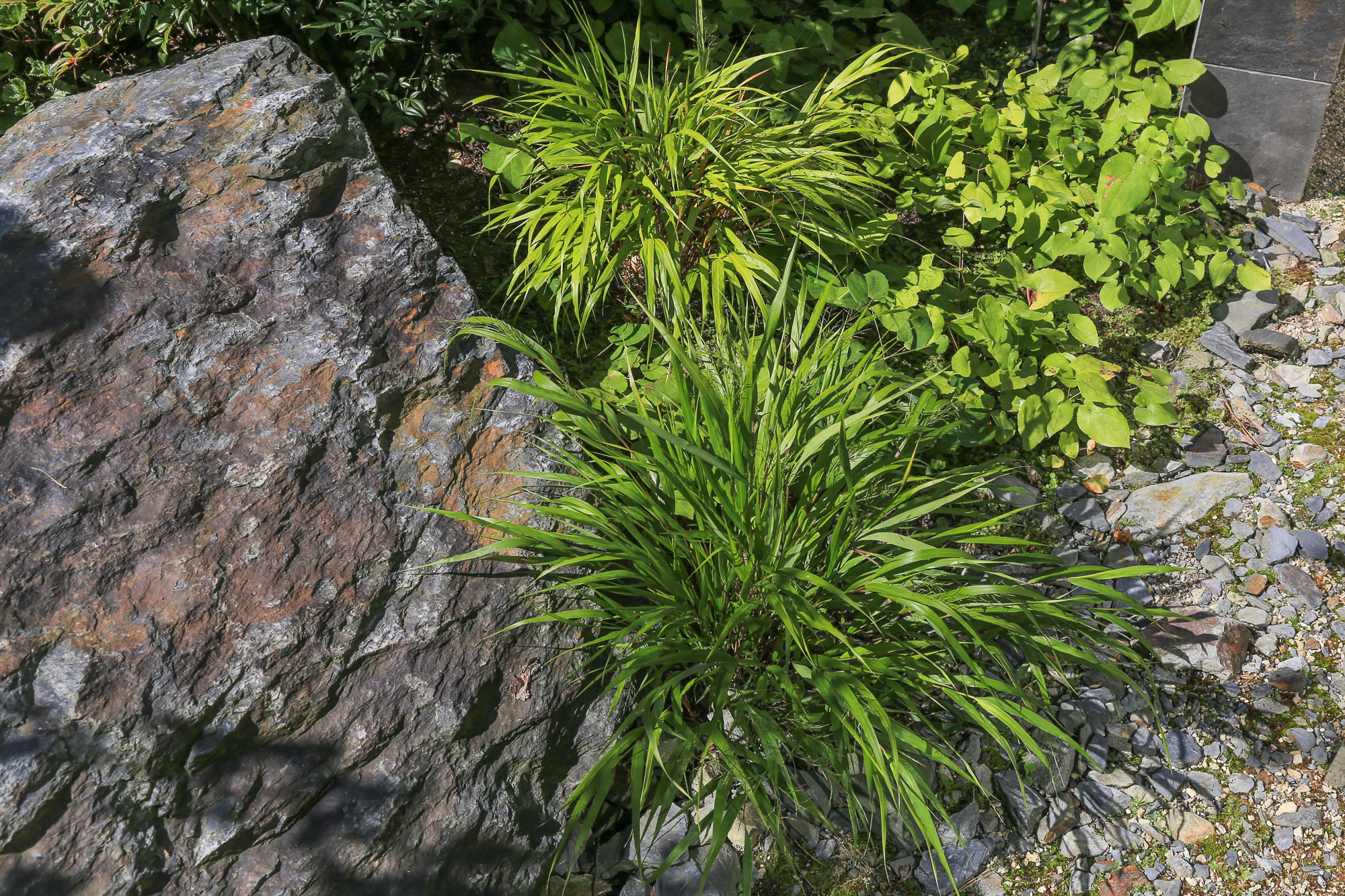 The plantings demonstrate deep knowledge of ecology-based planting as well as plant sociology (plants' preferences for growing in large or small groups, solitary plants, and so on). Anyone familiar with the German habitat-influenced perennial movement will recognize such groupings as these, which consider both plant ecology and sociology: "solitary plants along the water's edge in moist gravel," "bog and pond plants," "plants for moist conditions in small groups," "solitary grasses and ferns," "backyard bulbs in small groups between groundcovers," "solitary plants under trees," and plants for use in various depths of water. (These are my rough translations of the Dutch labels on the planting plans.)Some of the plants are so unusual (to me) that I misidentified them. What do you think the red-leafed plants in this photo are?
The plantings demonstrate deep knowledge of ecology-based planting as well as plant sociology (plants' preferences for growing in large or small groups, solitary plants, and so on). Anyone familiar with the German habitat-influenced perennial movement will recognize such groupings as these, which consider both plant ecology and sociology: "solitary plants along the water's edge in moist gravel," "bog and pond plants," "plants for moist conditions in small groups," "solitary grasses and ferns," "backyard bulbs in small groups between groundcovers," "solitary plants under trees," and plants for use in various depths of water. (These are my rough translations of the Dutch labels on the planting plans.)Some of the plants are so unusual (to me) that I misidentified them. What do you think the red-leafed plants in this photo are?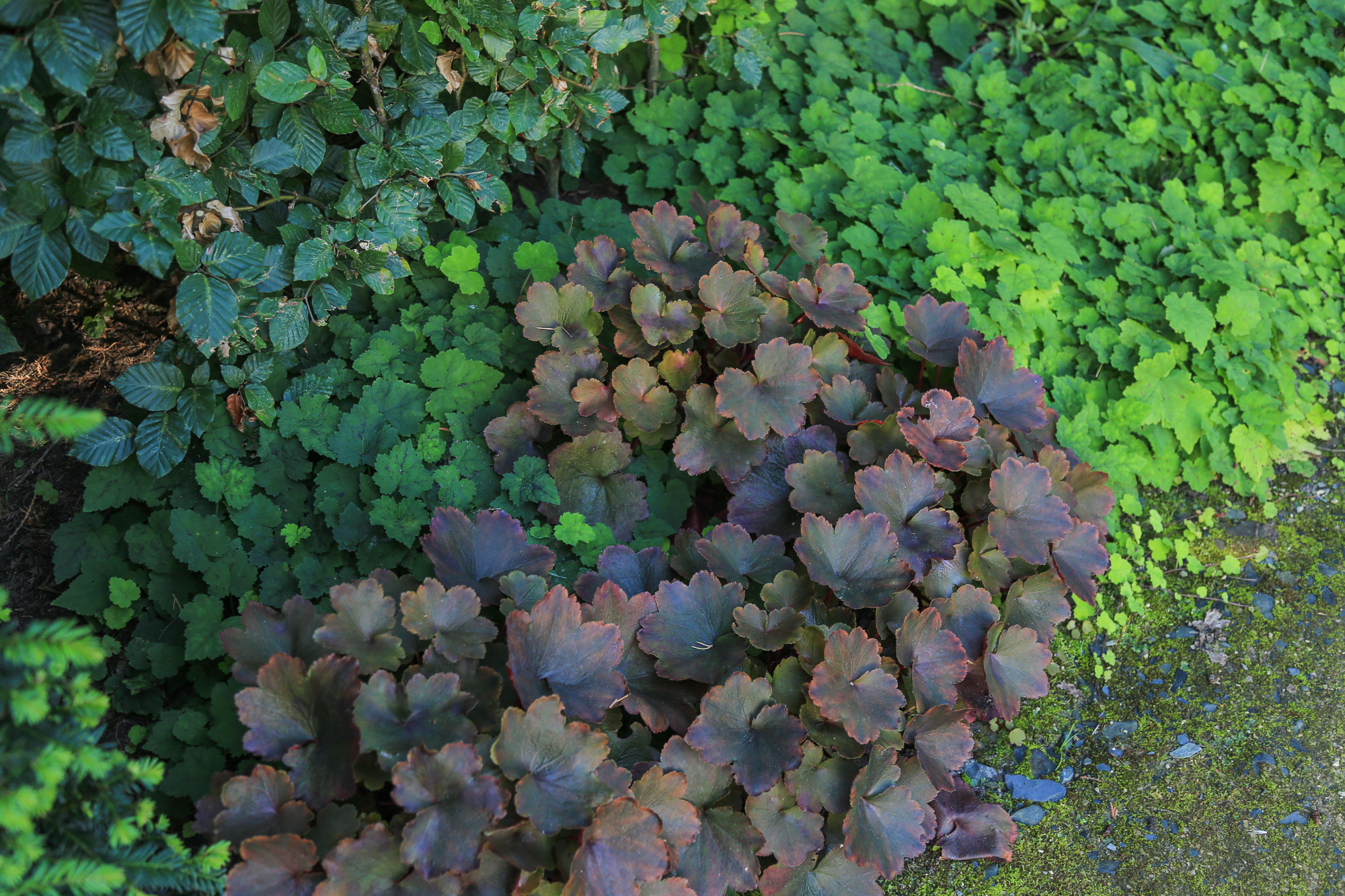 I thought I was seeing a new Heuchera with a ground cover of green Tiarella cordifolia. I was wrong. It's a Saxifrage (Saxifraga cortusifolia 'Rubrifolia'). And look at this miniature bit of nature between stones and a steel bridge plate. Viola, moss, baby ferns, seedling Saxifrages ...
I thought I was seeing a new Heuchera with a ground cover of green Tiarella cordifolia. I was wrong. It's a Saxifrage (Saxifraga cortusifolia 'Rubrifolia'). And look at this miniature bit of nature between stones and a steel bridge plate. Viola, moss, baby ferns, seedling Saxifrages ...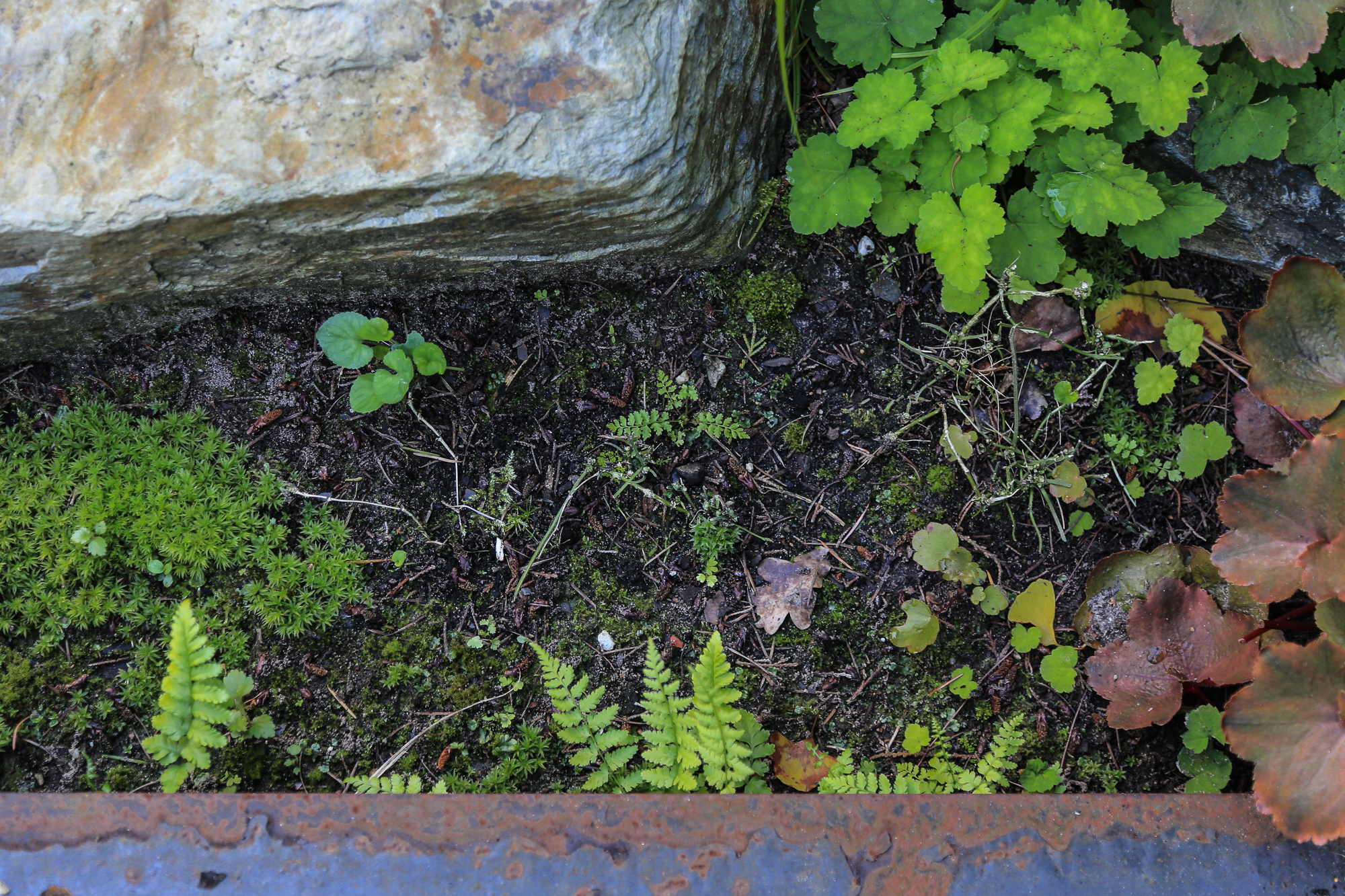 ... these plants aren't just surviving, they are reproducing and creating habitat in a garden less than two years old.The Garden EntranceThe entrance to the Japanese water garden is subtle and understated. We might call it an example of Wabi Sabi, appreciation for the beauty in the lowly and humble.
... these plants aren't just surviving, they are reproducing and creating habitat in a garden less than two years old.The Garden EntranceThe entrance to the Japanese water garden is subtle and understated. We might call it an example of Wabi Sabi, appreciation for the beauty in the lowly and humble.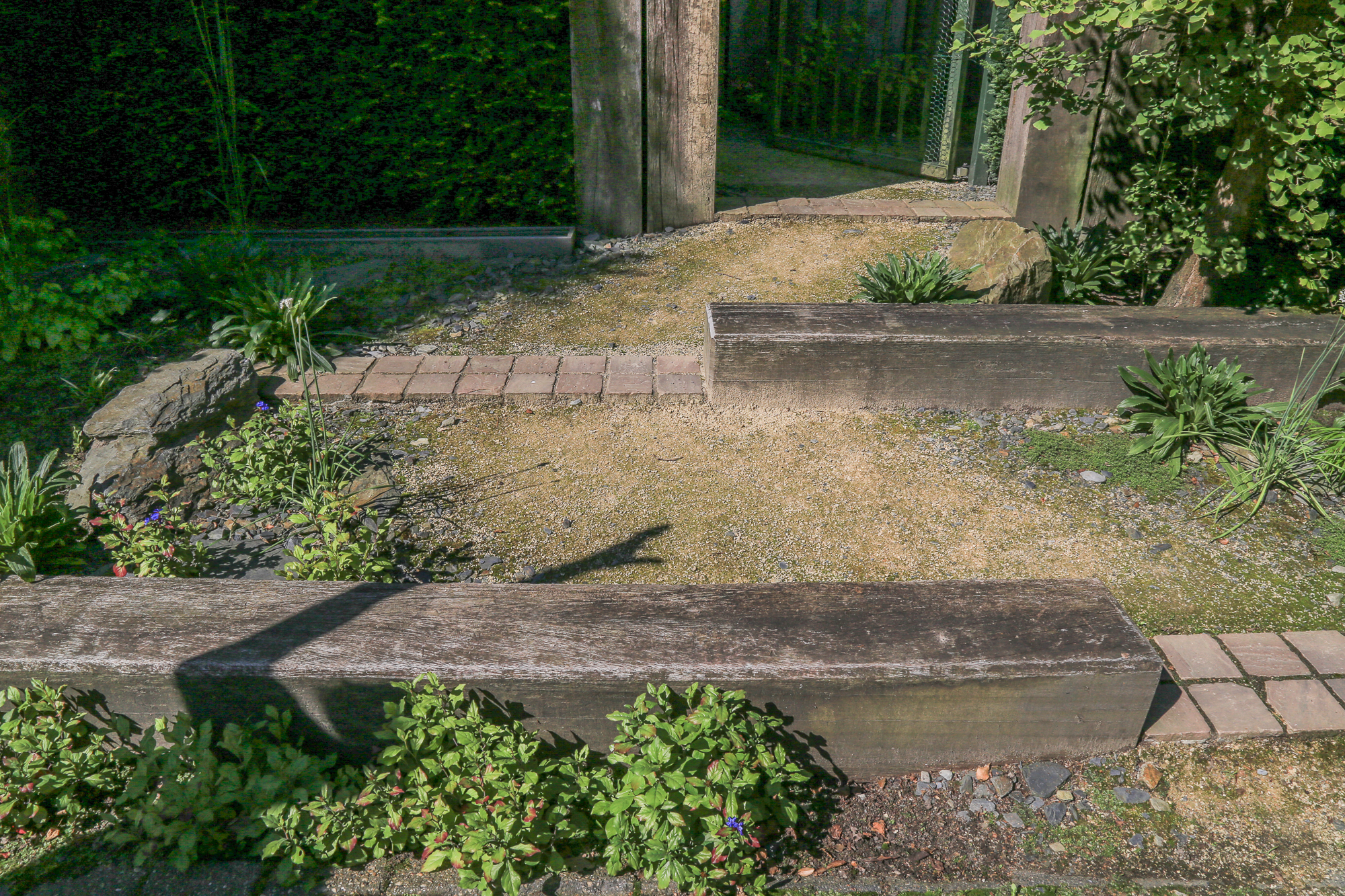 From the entry passage, used wooden bollards block the view into the garden, then gradually break apart into an abstracted series of verticals, giving glimpses in.
From the entry passage, used wooden bollards block the view into the garden, then gradually break apart into an abstracted series of verticals, giving glimpses in.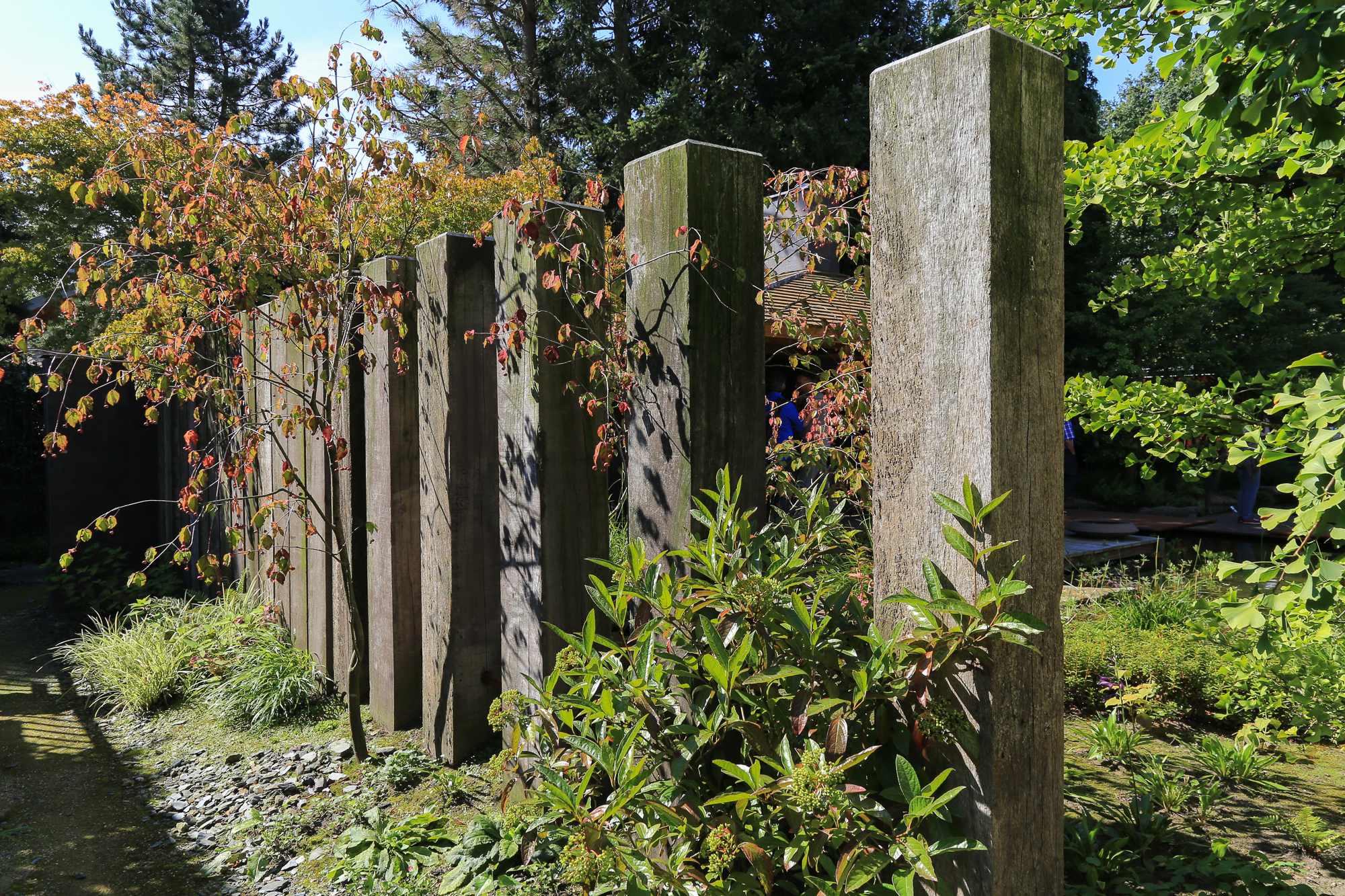 These solid, bulky forms (they are seven or eight feet tall) are given an elegance and visual interest by plantings of carex and low shrubs at ground level and red berried Euonymous europaea (Spindle tree) that catches the eye and carries it upward. A very Japanese characteristic--the display of subtle variations of color and texture across the worn surface of the wood, the play of light and shadow, is another Wabi Sabi touch.From the other side, the Euonymous are even more colorful, and beautifully offset by a few low grasses.
These solid, bulky forms (they are seven or eight feet tall) are given an elegance and visual interest by plantings of carex and low shrubs at ground level and red berried Euonymous europaea (Spindle tree) that catches the eye and carries it upward. A very Japanese characteristic--the display of subtle variations of color and texture across the worn surface of the wood, the play of light and shadow, is another Wabi Sabi touch.From the other side, the Euonymous are even more colorful, and beautifully offset by a few low grasses.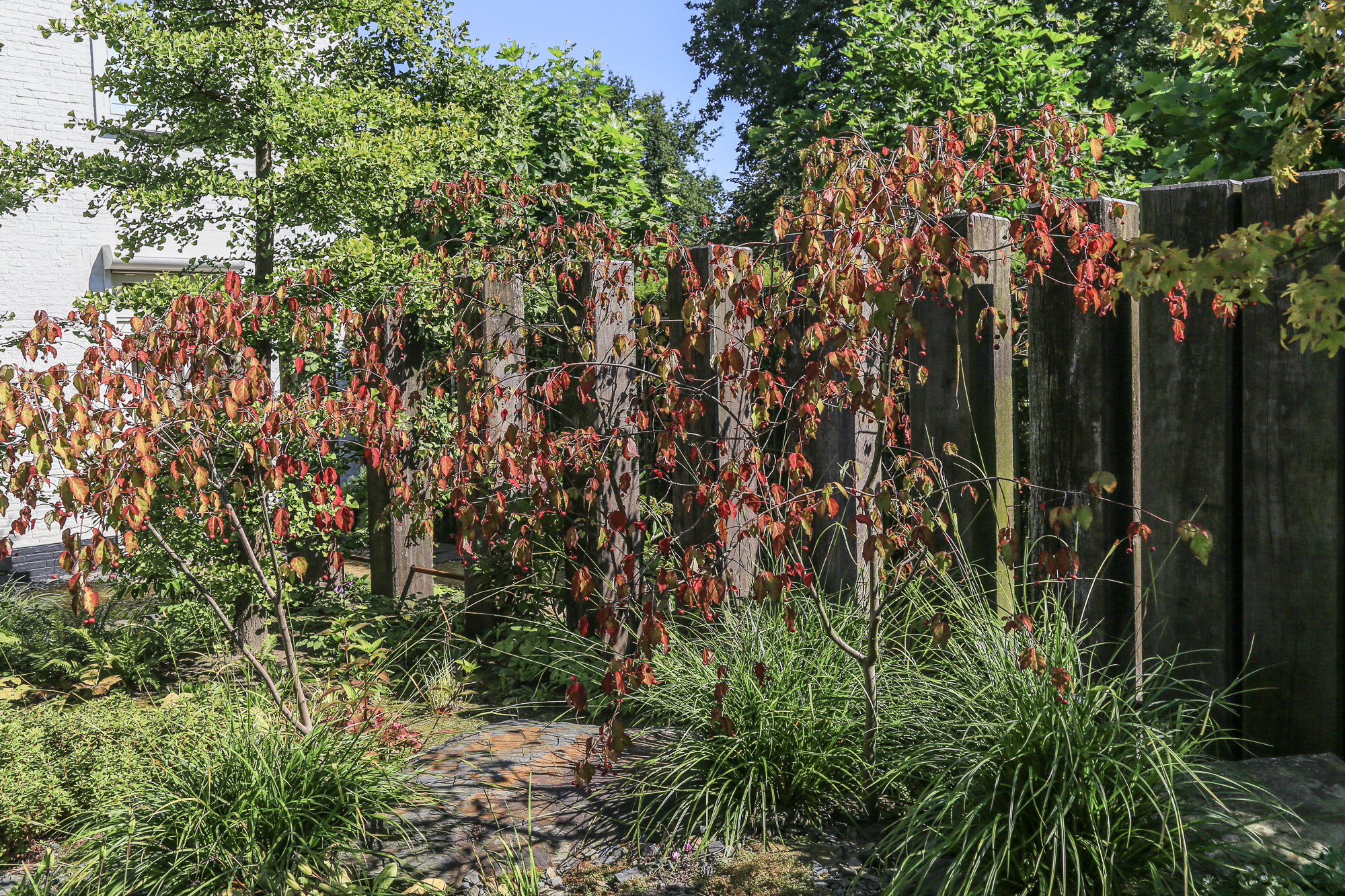 Van Mierlo works to achieve a balance (he uses the word "unity") between the many different elements of garden composition ...
Van Mierlo works to achieve a balance (he uses the word "unity") between the many different elements of garden composition ...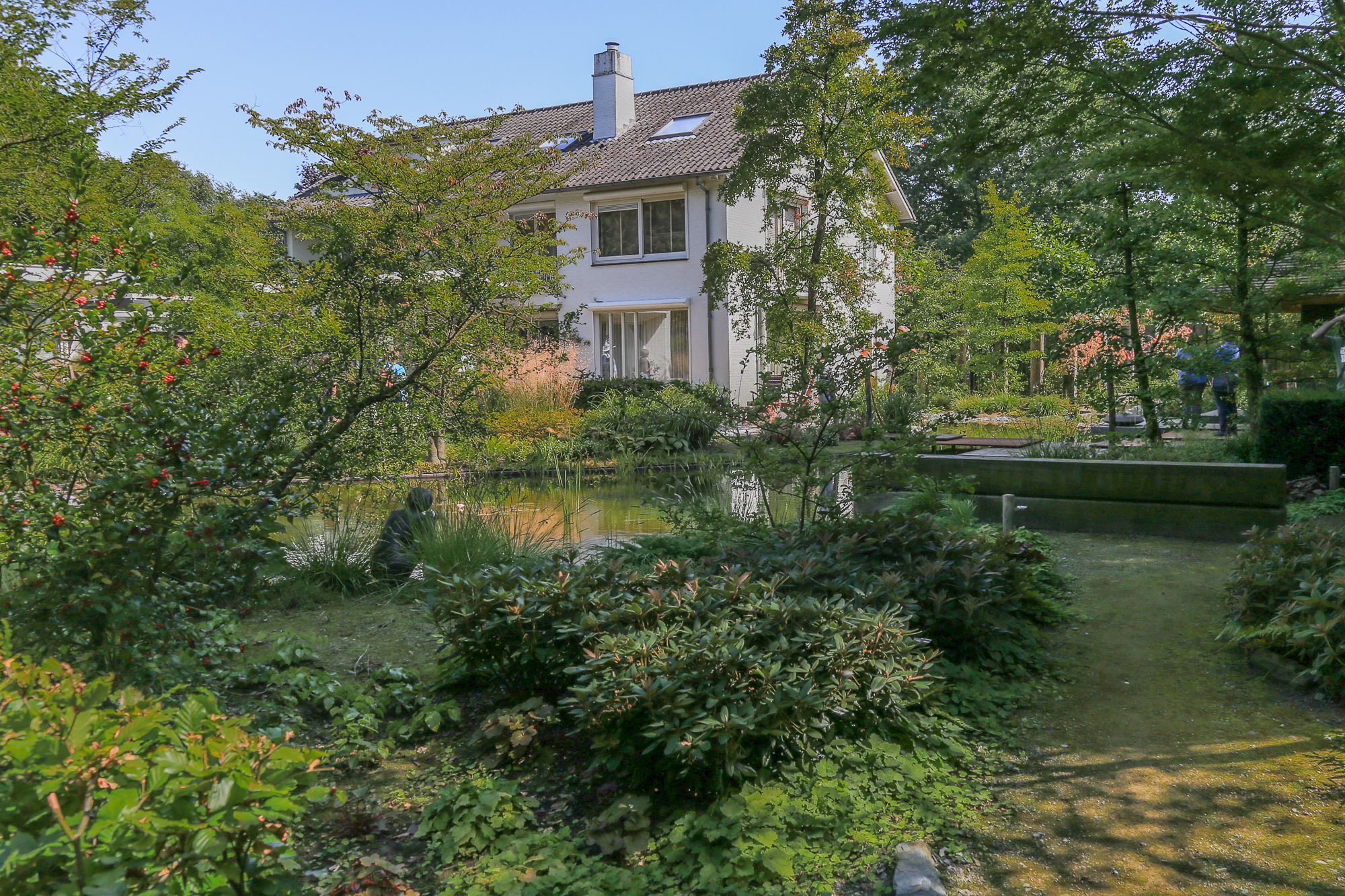 ... the floor of the garden (paving, water, ground covers, pathways, bridges, rocks, turf), the walls and furniture of the garden (structures, plants, seating, sculpture, trees), and the garden's roof (tree canopies and sky). This striving for unity of effect is visible, too, in his placement of such "added" elements as the client's sculpture--for example, this mysterious piece, seen above and more closely below ...
... the floor of the garden (paving, water, ground covers, pathways, bridges, rocks, turf), the walls and furniture of the garden (structures, plants, seating, sculpture, trees), and the garden's roof (tree canopies and sky). This striving for unity of effect is visible, too, in his placement of such "added" elements as the client's sculpture--for example, this mysterious piece, seen above and more closely below ...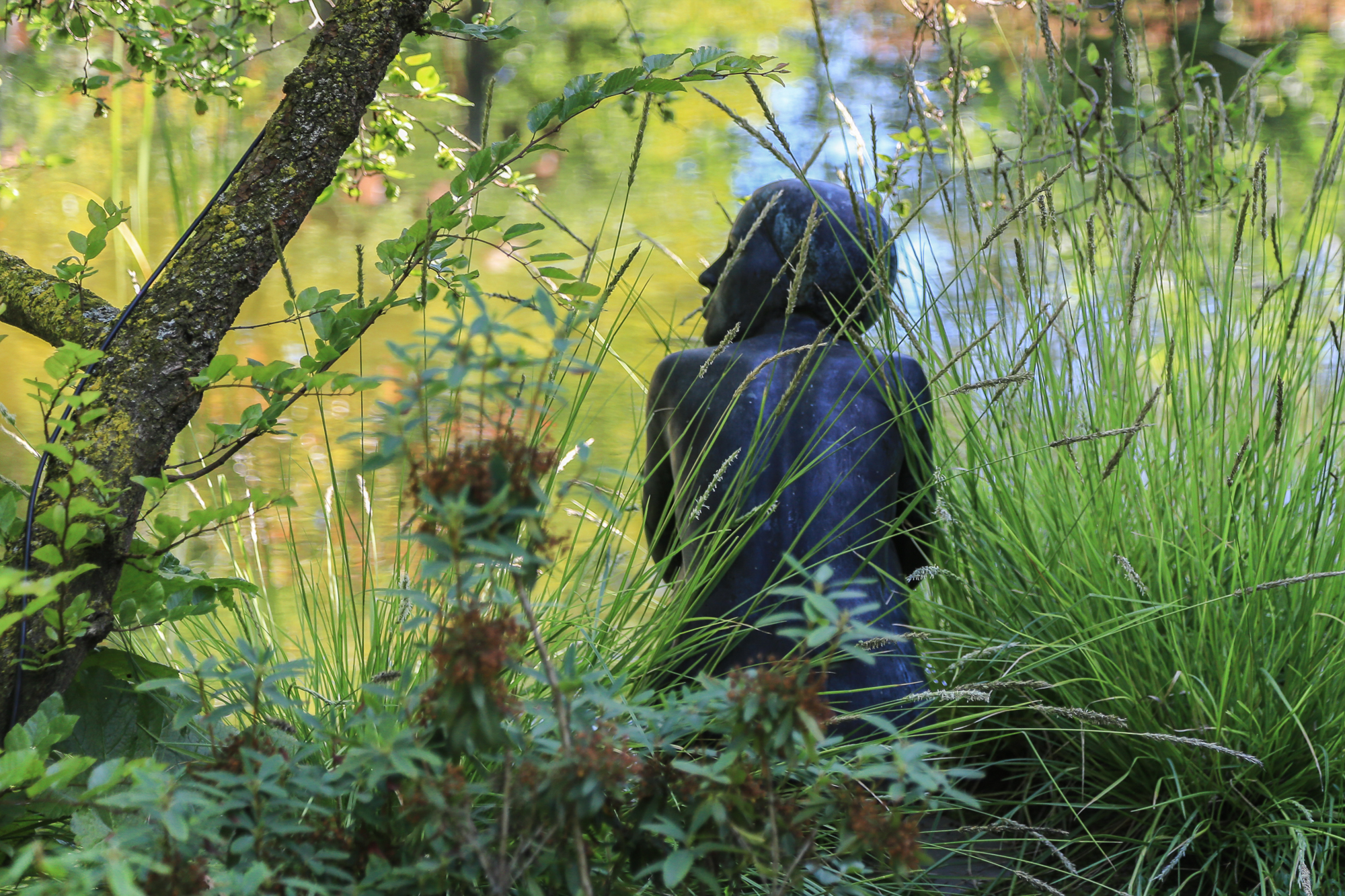 ... the black figure has been positioned before the water, in an emotionally meaningful context of grasses and shrubs that suggest a figure in hiding, waiting, musing ...
... the black figure has been positioned before the water, in an emotionally meaningful context of grasses and shrubs that suggest a figure in hiding, waiting, musing ...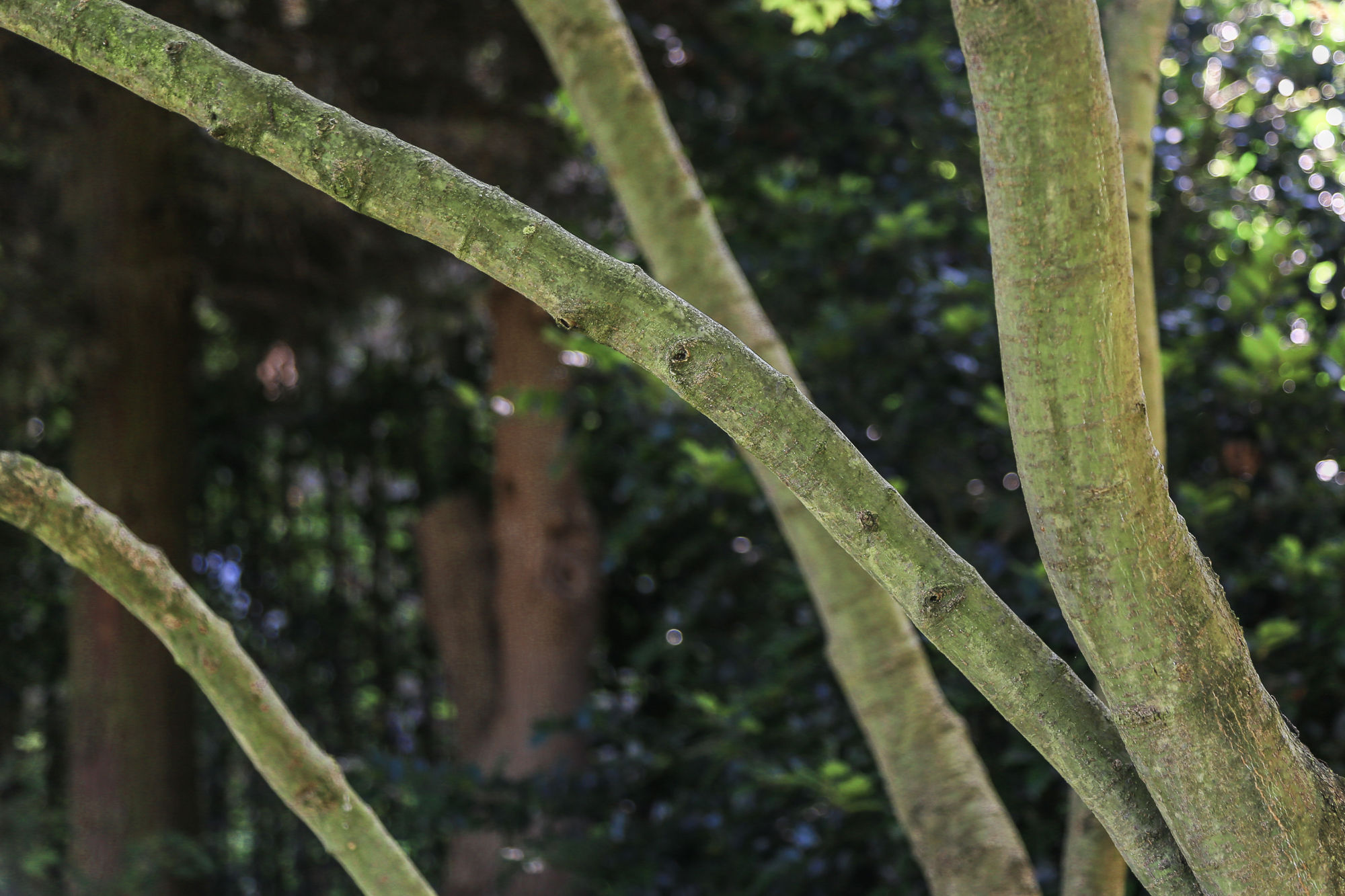 ... and so too, with this grouping of small tree trunks sloping in the shade, van Mierlo captures the eye with a subtle effect achieved as part of many elements in balance. Walking the garden is a richly sensory experience. Note (below) how gracefully the garden moves from a naturalistic path to a more formal passageway, which is necessary to accommodate space limitations at the border of the residential property ...
... and so too, with this grouping of small tree trunks sloping in the shade, van Mierlo captures the eye with a subtle effect achieved as part of many elements in balance. Walking the garden is a richly sensory experience. Note (below) how gracefully the garden moves from a naturalistic path to a more formal passageway, which is necessary to accommodate space limitations at the border of the residential property ... ... bringing the garden visitor around to this lawn, and then the house and its outside entertainment areas.
... bringing the garden visitor around to this lawn, and then the house and its outside entertainment areas.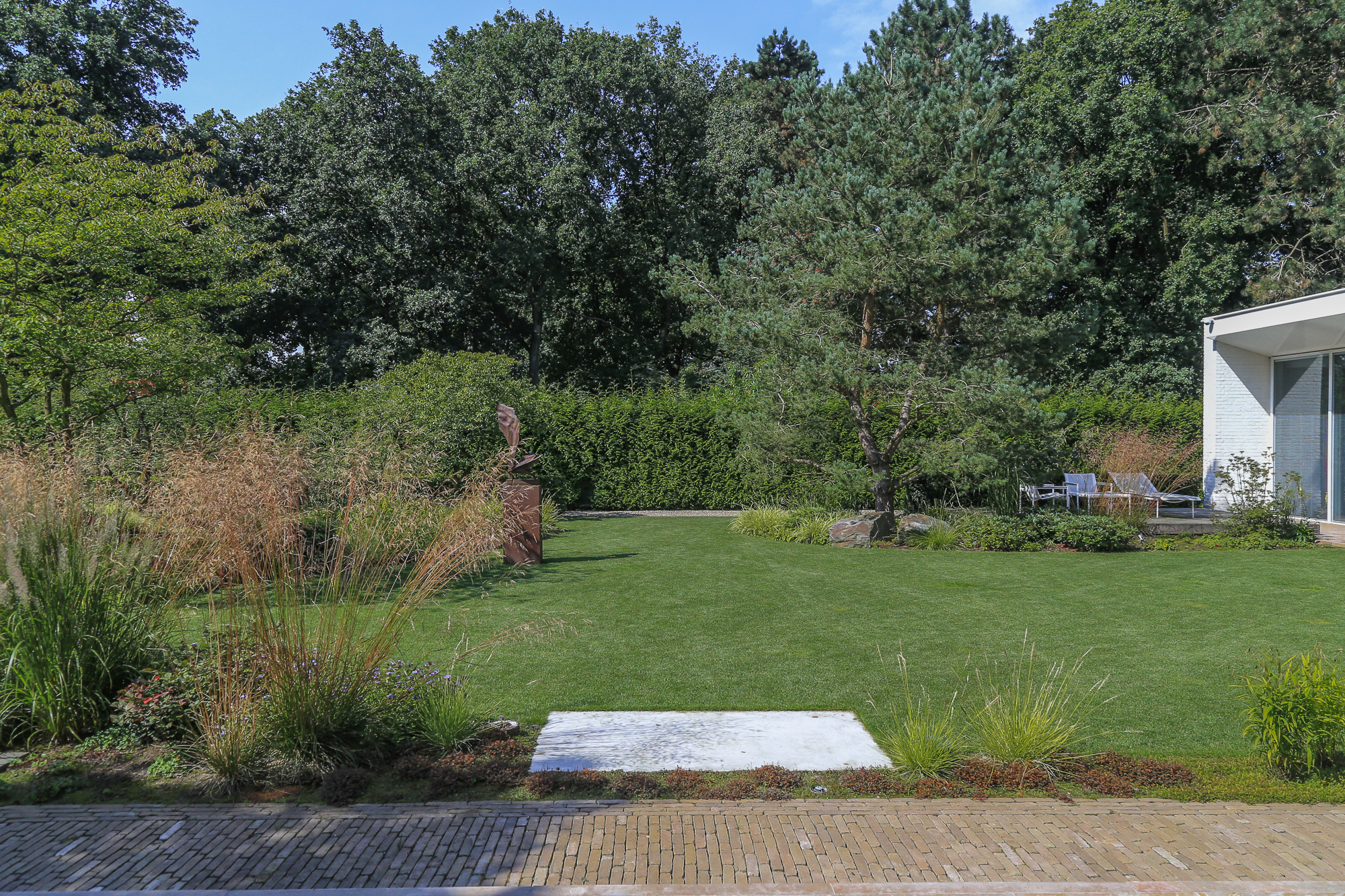
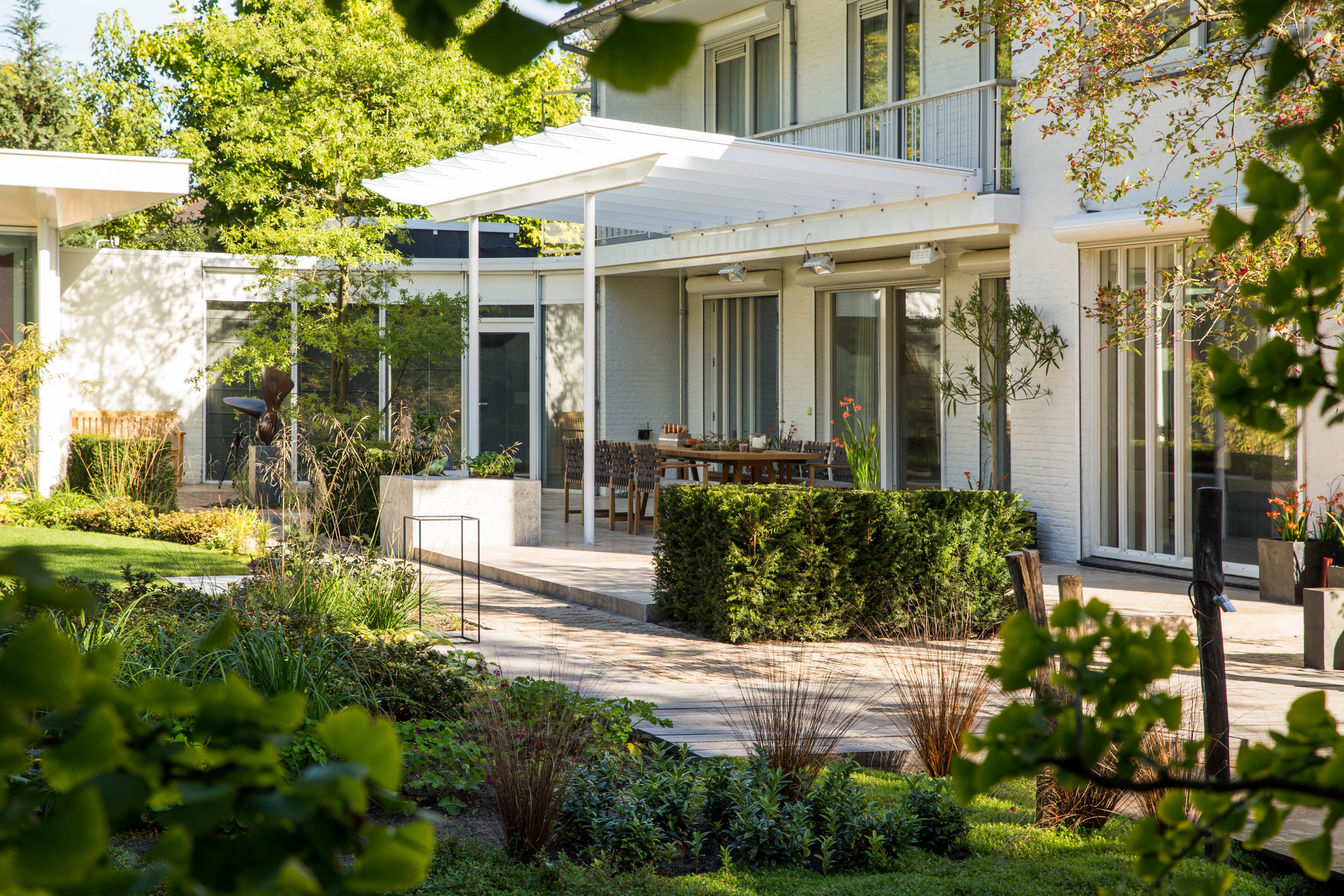
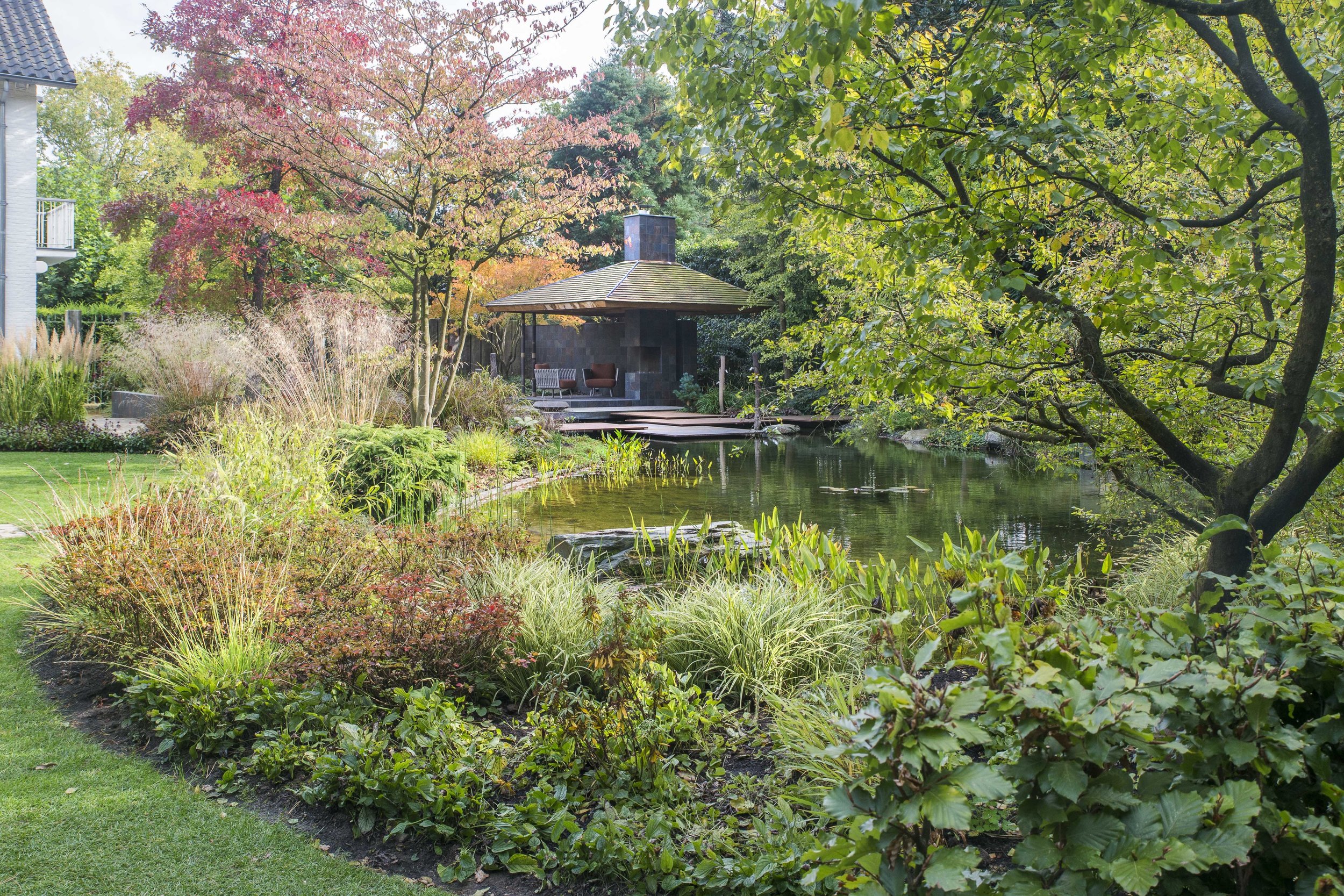 Even on the utility, or entertainment, side of the garden, artful plantings and simple appointments continue the contemplative atmosphere.
Even on the utility, or entertainment, side of the garden, artful plantings and simple appointments continue the contemplative atmosphere.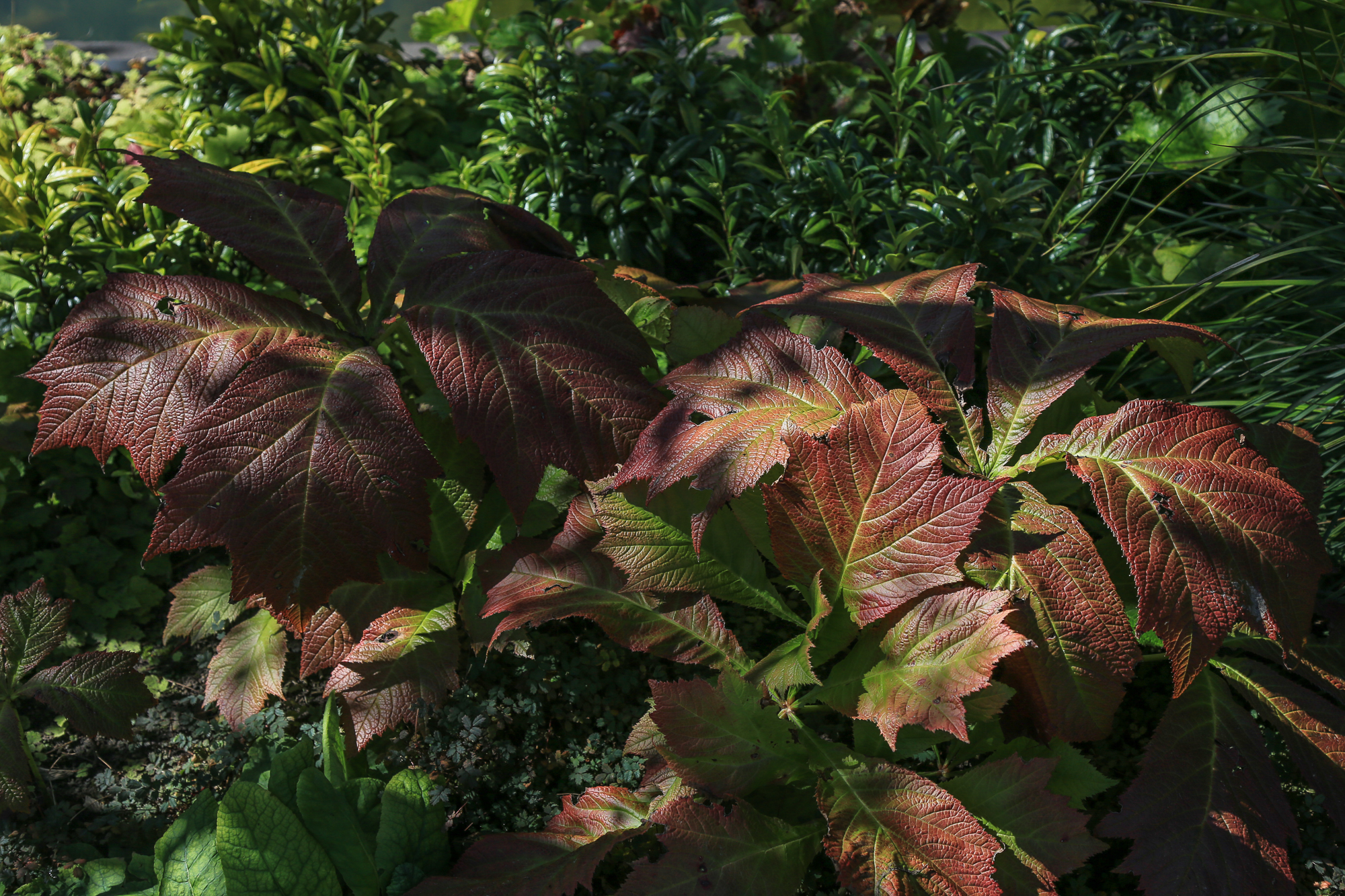
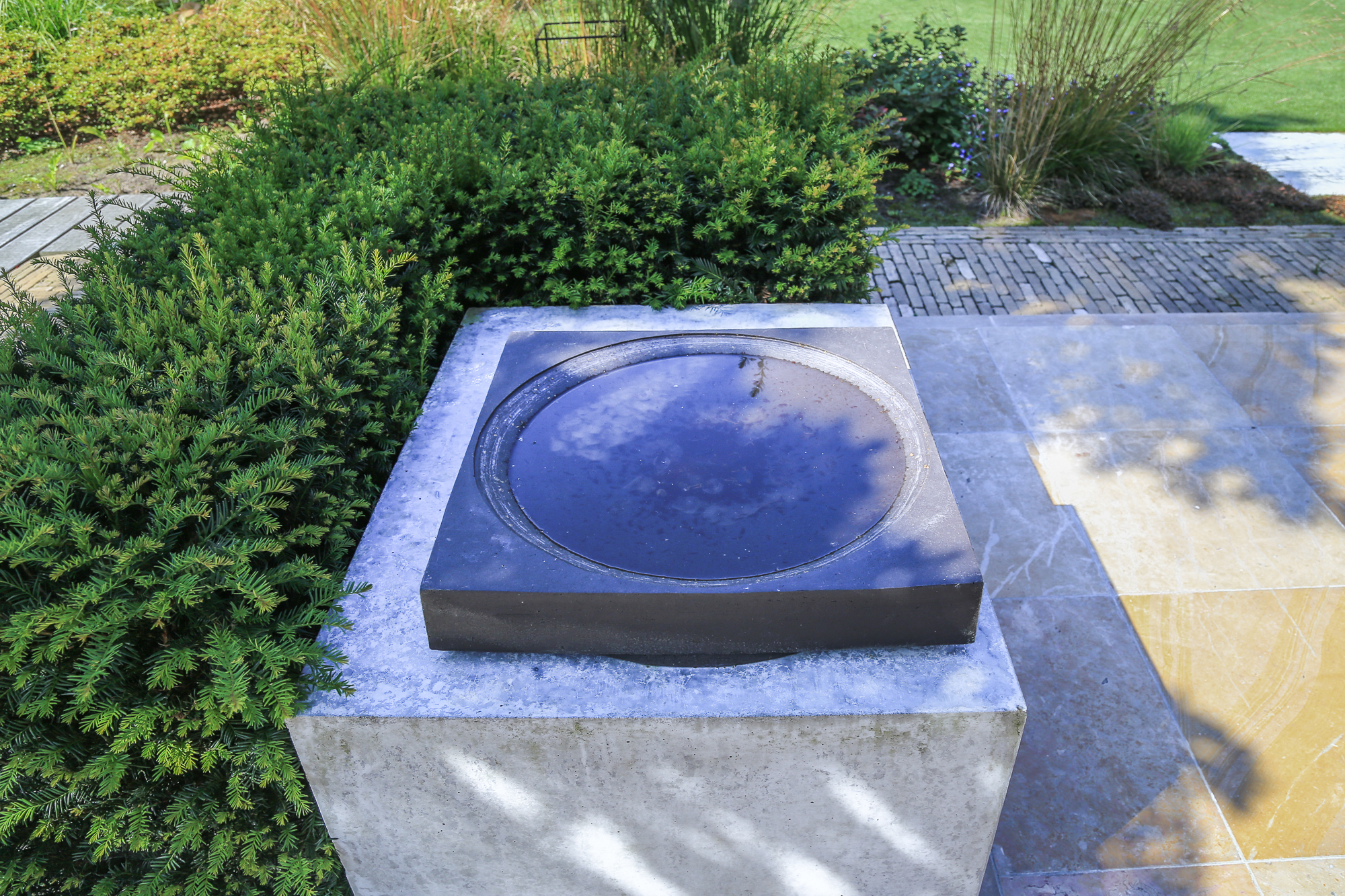 The Japanese water garden is very much a journey. Movement from the entrance is choreographed by landscape and structural elements to carry the visitor into the garden, across the bridge of steel plates to the tea house, then around the far side of the pond on a simple path embellished by ecological plantings, around the back of the property, onto the lawn and entertainment precinct of the house ...
The Japanese water garden is very much a journey. Movement from the entrance is choreographed by landscape and structural elements to carry the visitor into the garden, across the bridge of steel plates to the tea house, then around the far side of the pond on a simple path embellished by ecological plantings, around the back of the property, onto the lawn and entertainment precinct of the house ...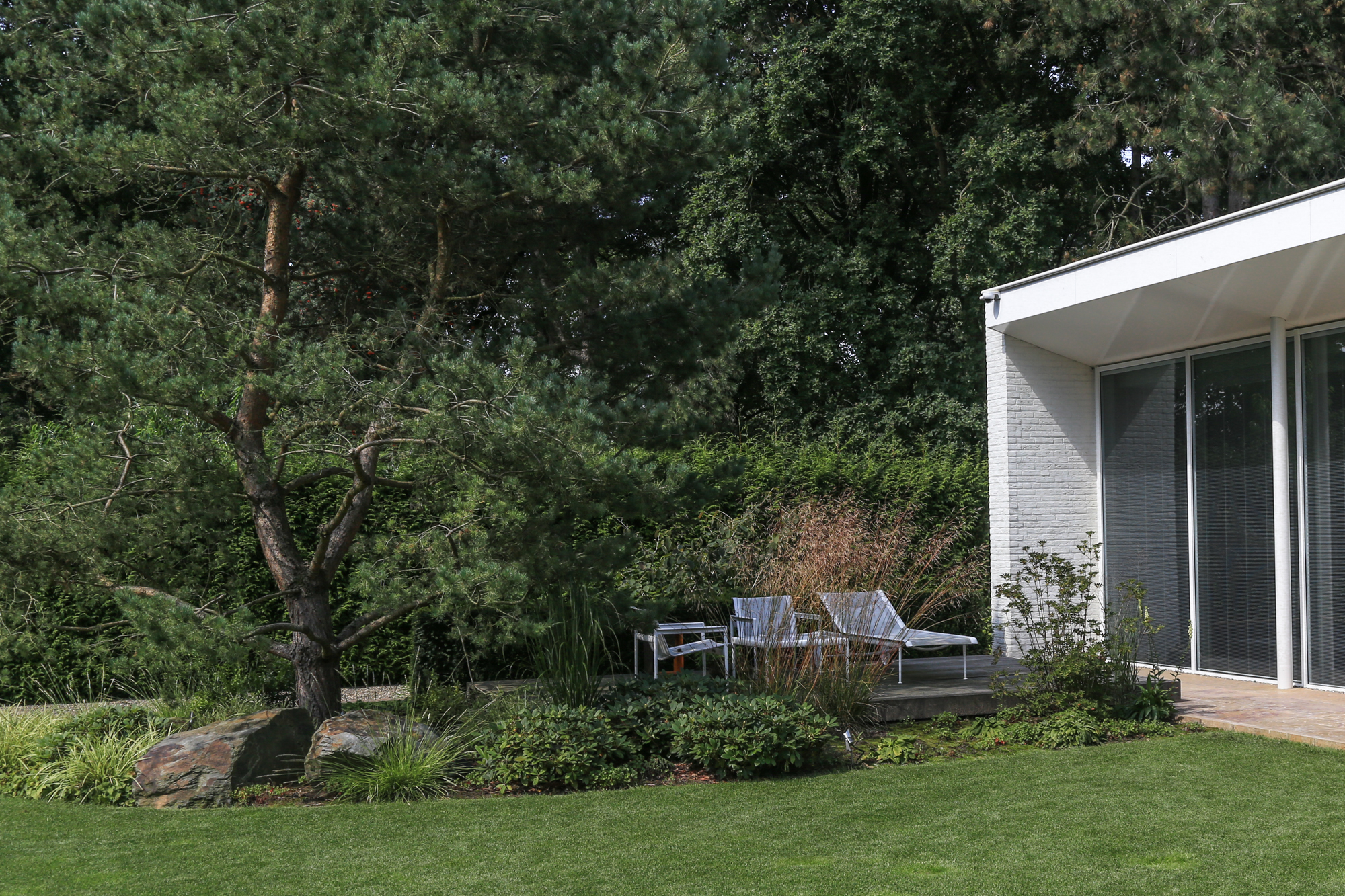 ... that journey can continue across the pond again, with resting places in the tea house, and around the lawn. It is a compact journey, but it offers compelling transitions in mood.To see a video showing how the garden was built, click here.The other garden we visited, the Stream garden, contains many of the same elements, and it too uses water and rock as principal elements of composition.The Stream Garden
... that journey can continue across the pond again, with resting places in the tea house, and around the lawn. It is a compact journey, but it offers compelling transitions in mood.To see a video showing how the garden was built, click here.The other garden we visited, the Stream garden, contains many of the same elements, and it too uses water and rock as principal elements of composition.The Stream Garden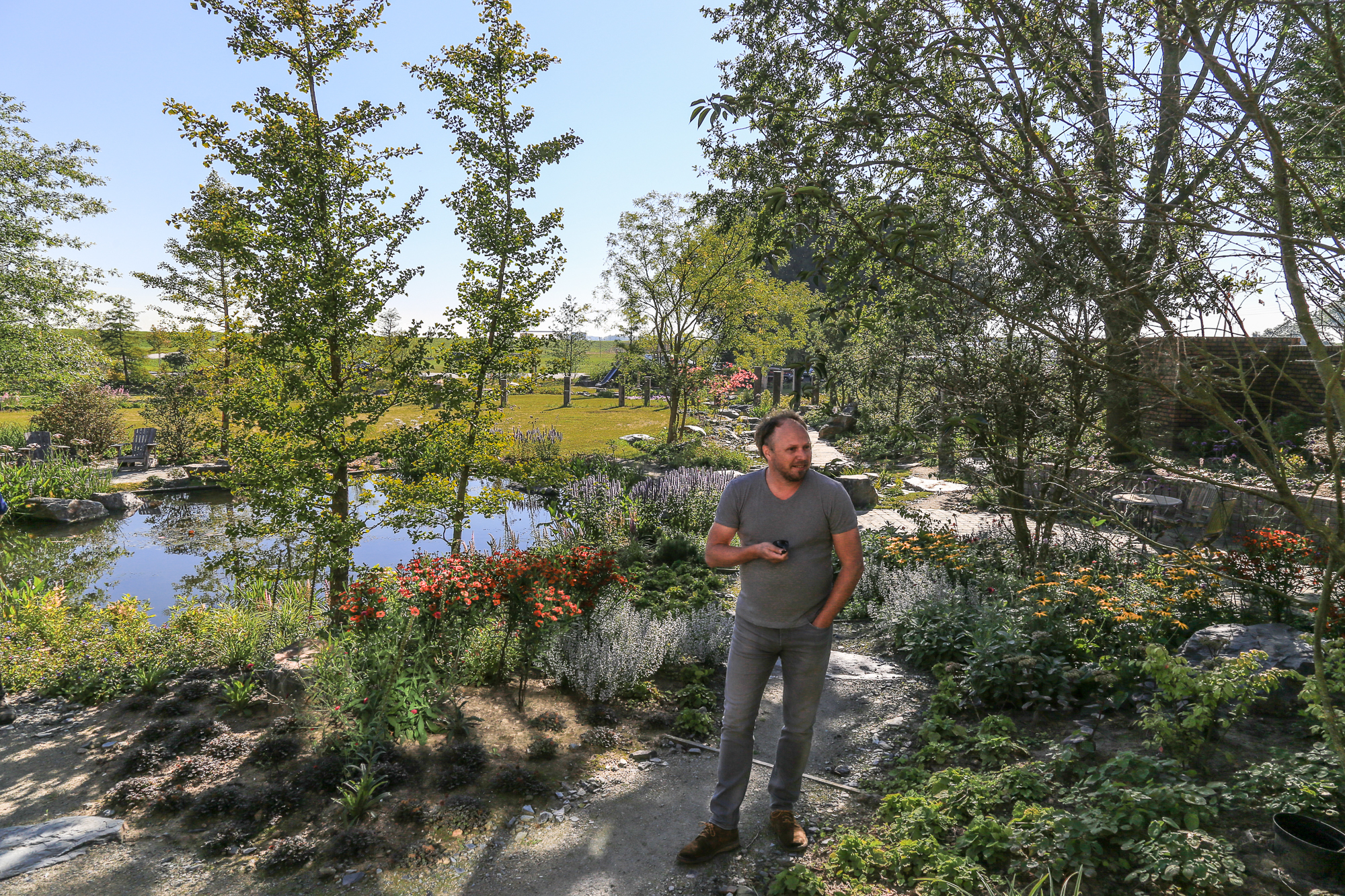 The other van Mierlo garden we saw was newly constructed and very recently planted. The Stream garden is located in front of the owner's house in the polders (low land rescued from the sea), and it is surrounded, at a distance, by high dykes. It appeared to be a difficult site for a garden, offering little of interest.
The other van Mierlo garden we saw was newly constructed and very recently planted. The Stream garden is located in front of the owner's house in the polders (low land rescued from the sea), and it is surrounded, at a distance, by high dykes. It appeared to be a difficult site for a garden, offering little of interest.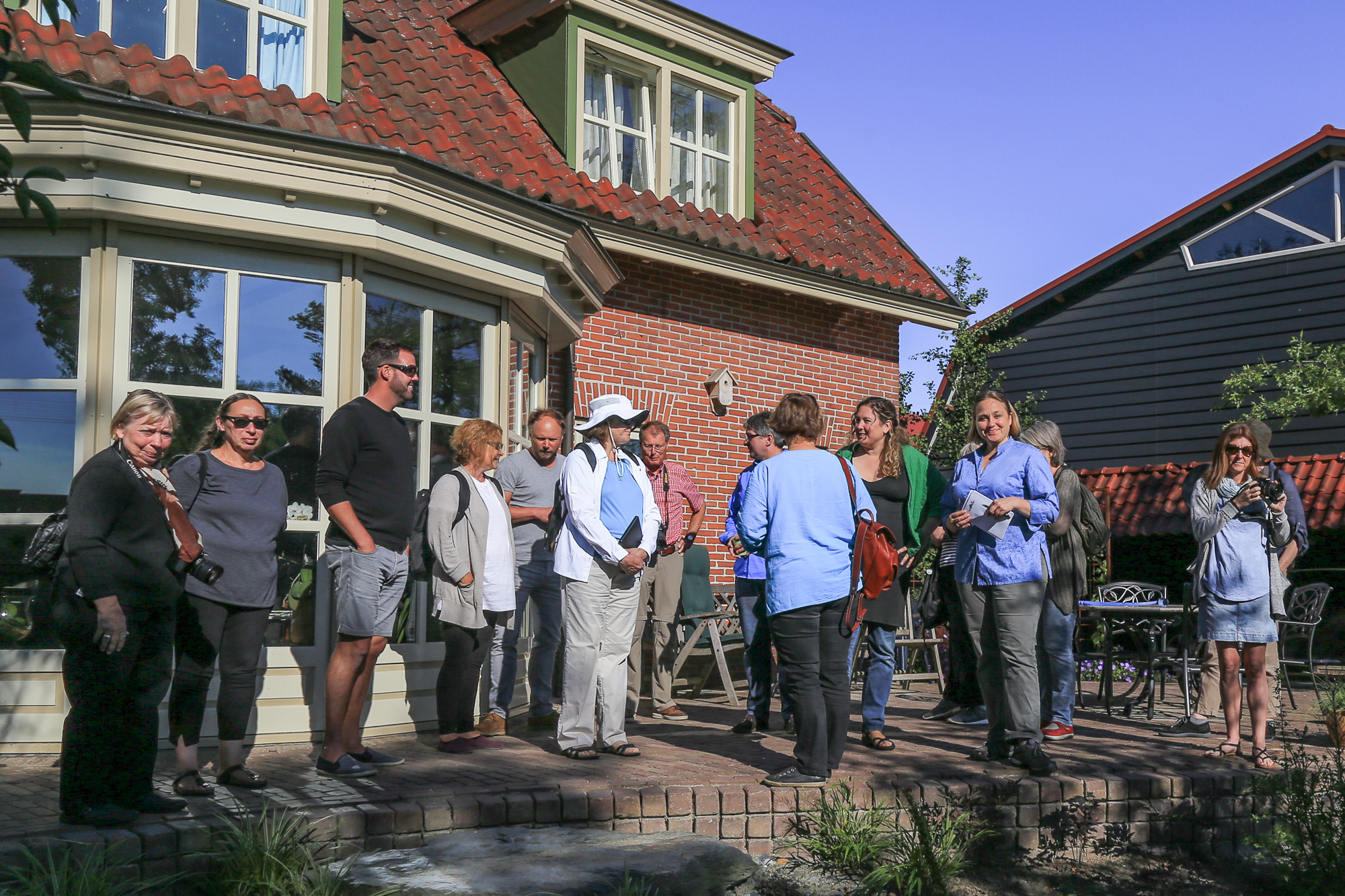 Since such land is intrinsically lacking in interest, though it does has its own sense of place, van Mierlo's client specifically requested a landscape that would bring him to another place ...
Since such land is intrinsically lacking in interest, though it does has its own sense of place, van Mierlo's client specifically requested a landscape that would bring him to another place ...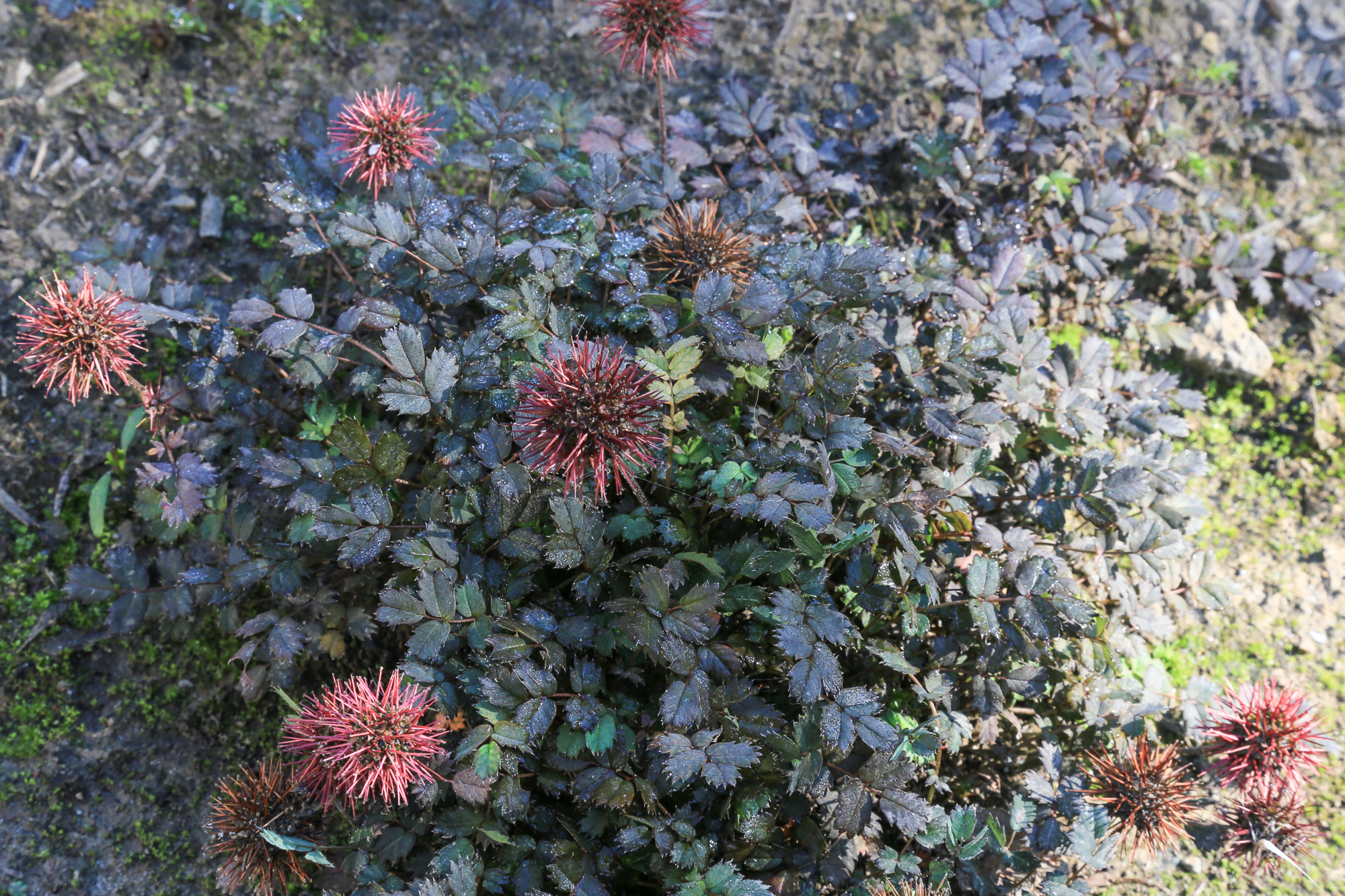 ... one that reminded him of his many summers walking rocky streams in the mountains of Austria. When questioned about that, the client said, "Have you seen Lord of the Rings?" That was enough of a clue.
... one that reminded him of his many summers walking rocky streams in the mountains of Austria. When questioned about that, the client said, "Have you seen Lord of the Rings?" That was enough of a clue.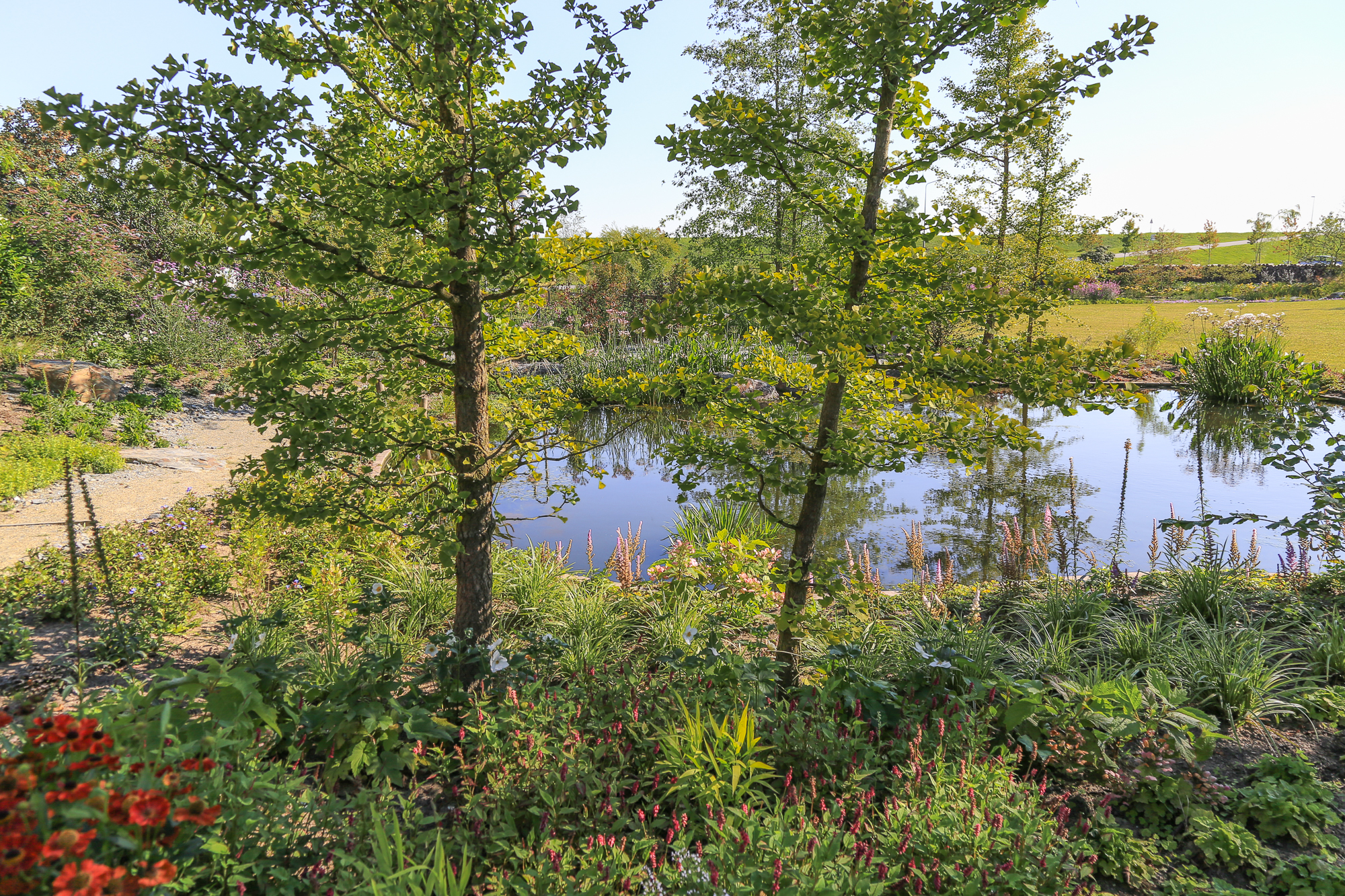 This is largely a linear garden built along a very natural-looking artificial stream, with wider areas encompassing the residence and associated buildings and a pond at one end, and a play area outside a terminus marked by great wooden bollards, at the far end. The trees used here are, like those in the Japanese water garden, selected for unique form and character.
This is largely a linear garden built along a very natural-looking artificial stream, with wider areas encompassing the residence and associated buildings and a pond at one end, and a play area outside a terminus marked by great wooden bollards, at the far end. The trees used here are, like those in the Japanese water garden, selected for unique form and character.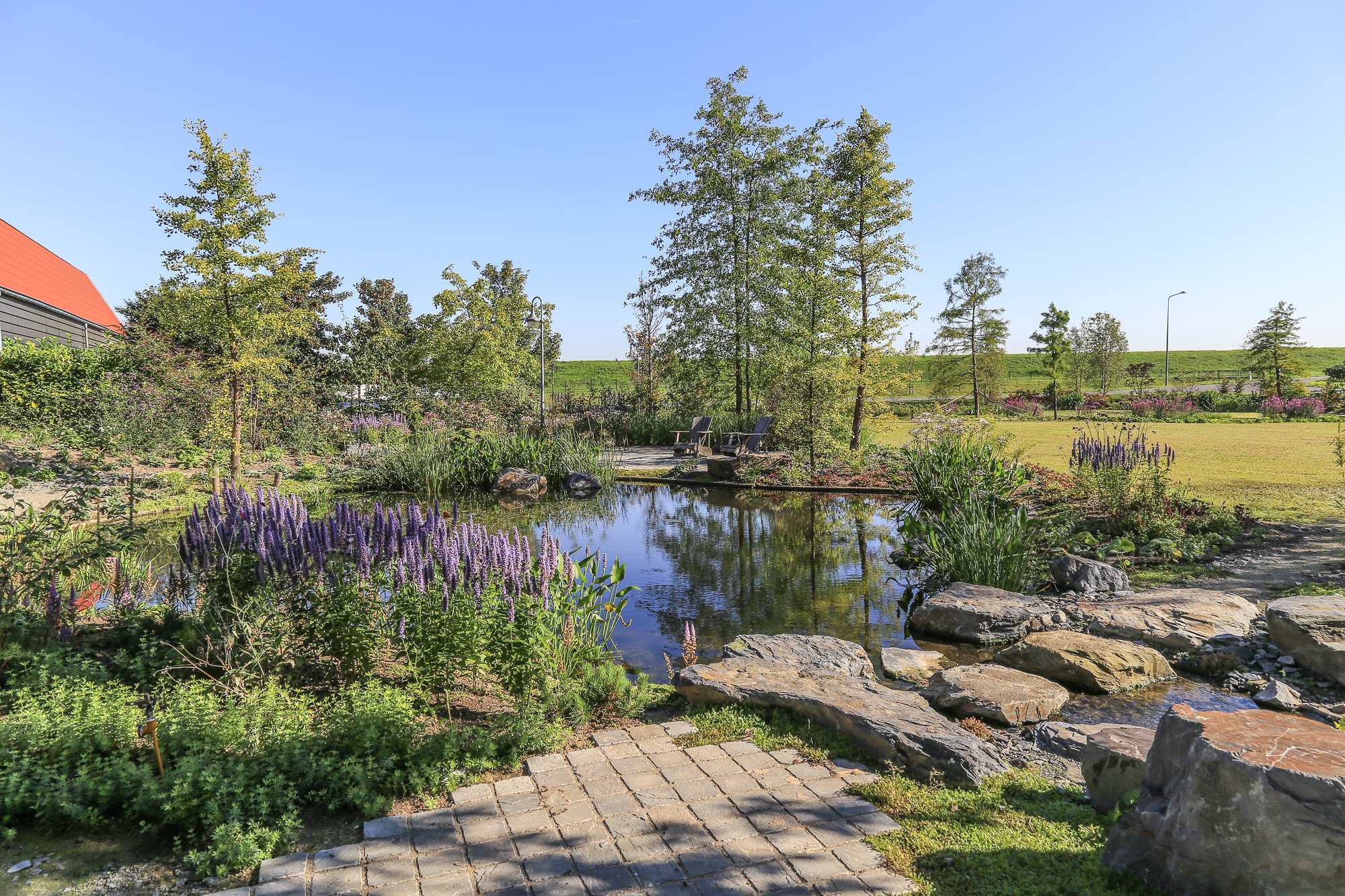 Stone, which is not normally present in The Netherlands, is a prominent feature in both the Japanese water garden and the Stream garden, but more so here, and its artful use is an essential element in the success of this garden. It is used to ...
Stone, which is not normally present in The Netherlands, is a prominent feature in both the Japanese water garden and the Stream garden, but more so here, and its artful use is an essential element in the success of this garden. It is used to ... ... create sense of place in a site that is essentially a blank canvas. But the stone does more. It makes the gardens "belong" in the landscape by virtue of its sheer physicality. Stones are selected with great care for shape, for how well they work in groups, for color, texture, size. And the stone helps to unify all the elements of the garden floor--gravel, wood, plants, paths, water.
... create sense of place in a site that is essentially a blank canvas. But the stone does more. It makes the gardens "belong" in the landscape by virtue of its sheer physicality. Stones are selected with great care for shape, for how well they work in groups, for color, texture, size. And the stone helps to unify all the elements of the garden floor--gravel, wood, plants, paths, water.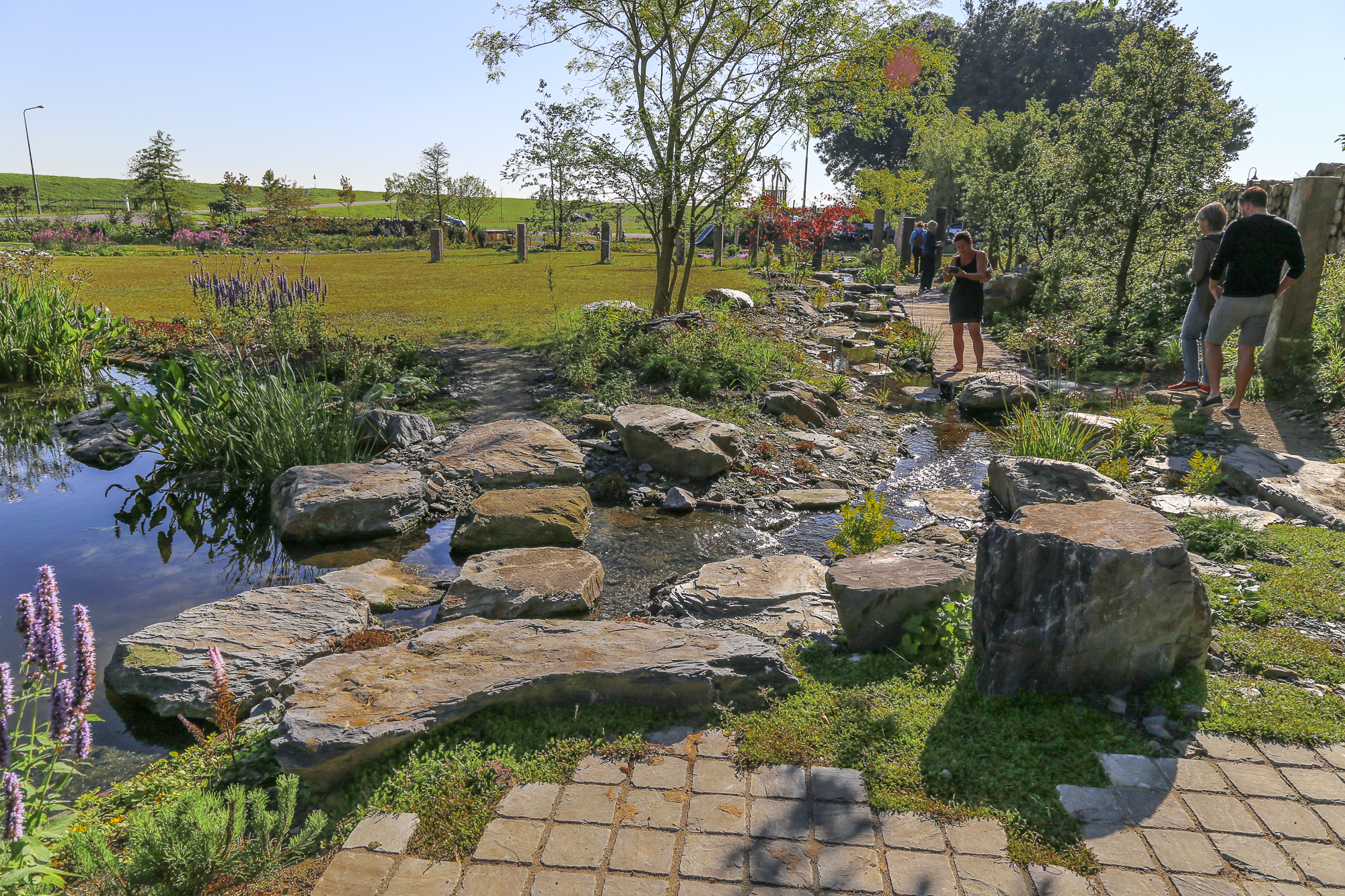 Stone adds an element of mystery too, a primal sense of presence, much as we experience in ancient sites such as Stonehenge, or at many lesser ancient sites.
Stone adds an element of mystery too, a primal sense of presence, much as we experience in ancient sites such as Stonehenge, or at many lesser ancient sites.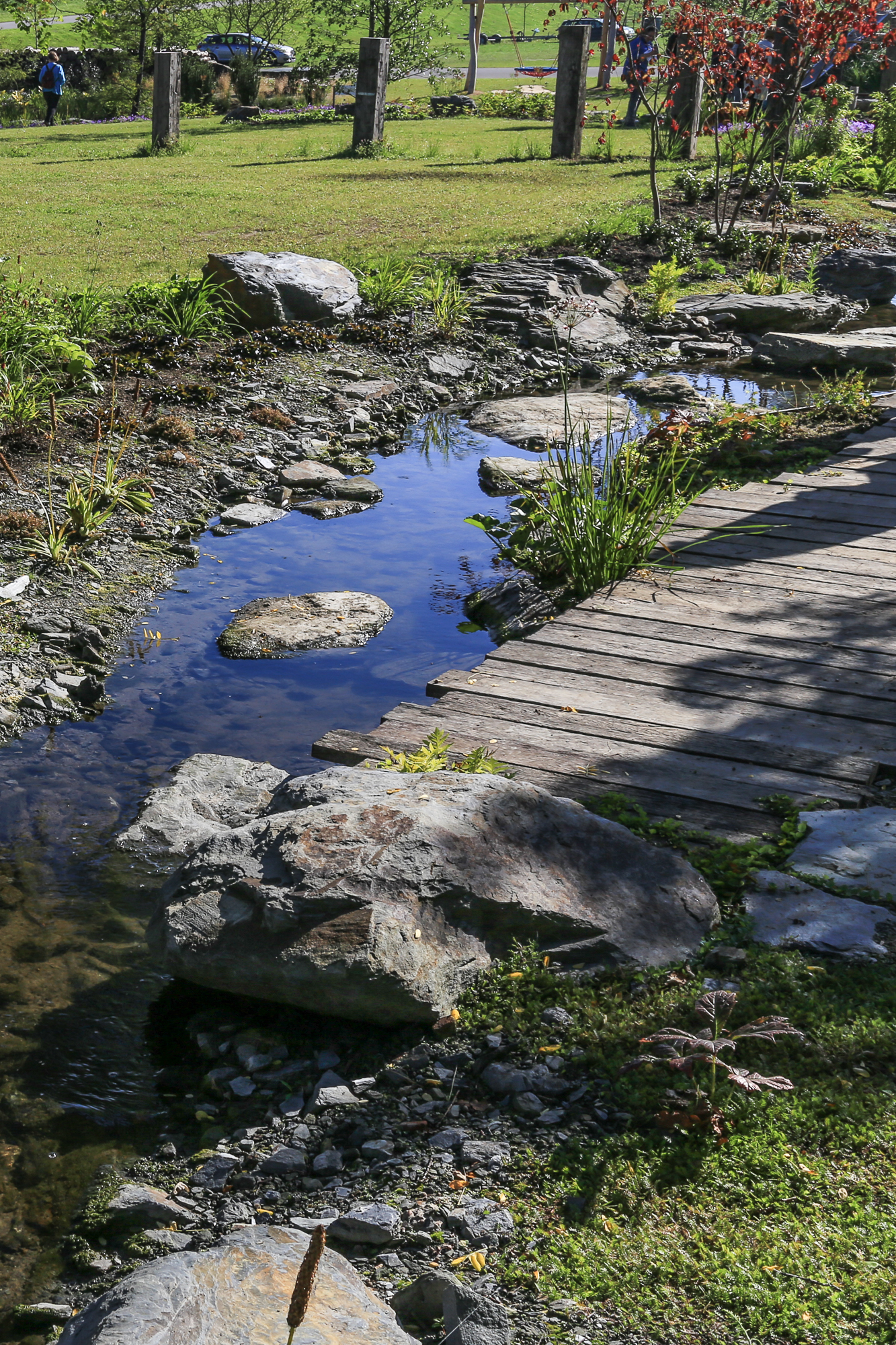 They also suggest (as above) the natural geologic processes of nature (here an artful illusion), processes that work over millennia, and thus introduce a sense of the immense time scales of geologic processes (hints of Lord of the Rings here?). Strewn across the landscape, they suggest they might have had a glacial origin. It's all sleight of hand, of course, but a very effective magic show. The rough, worn surface of the wooden walkway continues the color of the stone in an alternative material, an organic material, that again suggests the concept of Wabi Sabi.
They also suggest (as above) the natural geologic processes of nature (here an artful illusion), processes that work over millennia, and thus introduce a sense of the immense time scales of geologic processes (hints of Lord of the Rings here?). Strewn across the landscape, they suggest they might have had a glacial origin. It's all sleight of hand, of course, but a very effective magic show. The rough, worn surface of the wooden walkway continues the color of the stone in an alternative material, an organic material, that again suggests the concept of Wabi Sabi. The stonescaping, and the intentional irregularity of the wooden walkway, create a strong sense of place, which will "mature" as the rocks and wood age in place.
The stonescaping, and the intentional irregularity of the wooden walkway, create a strong sense of place, which will "mature" as the rocks and wood age in place. The log wall (above) will age to a color that approximates the grey of the stone and of the three vertical wooden bollards. This wall is essential; on the other side, is an active marina, operated by the owner of the garden.
The log wall (above) will age to a color that approximates the grey of the stone and of the three vertical wooden bollards. This wall is essential; on the other side, is an active marina, operated by the owner of the garden.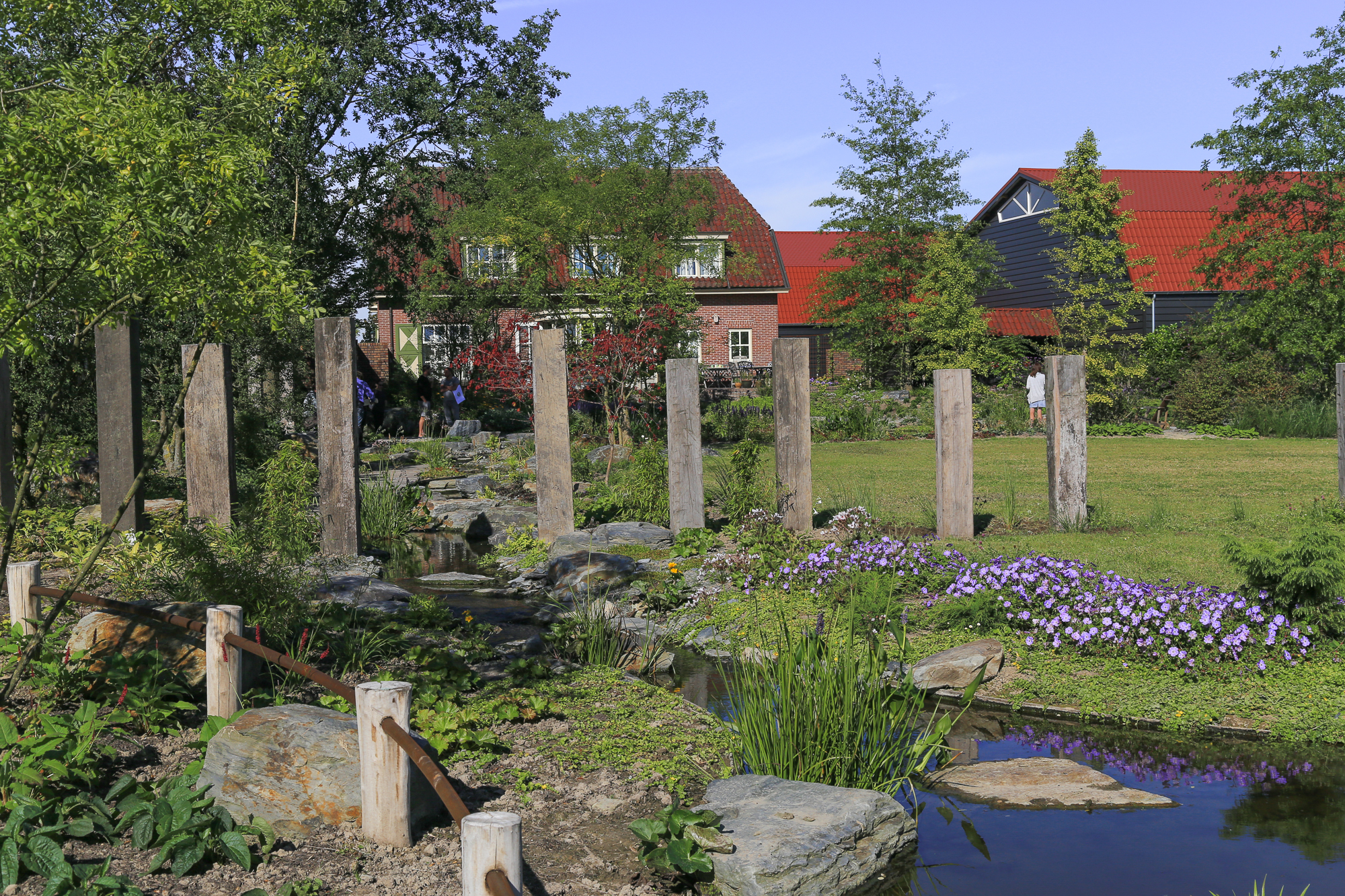 A line of wooden bollards, a common sight along waterfronts in The Netherlands, demarks the far end of the garden, separating a children's play area from the garden proper. Even here van Mierlo uses mounded sand, rock, and grass to suggest a feeling of seaside play.
A line of wooden bollards, a common sight along waterfronts in The Netherlands, demarks the far end of the garden, separating a children's play area from the garden proper. Even here van Mierlo uses mounded sand, rock, and grass to suggest a feeling of seaside play. One of our tour members couldn't resist this swing.
One of our tour members couldn't resist this swing. Van Mierlo says his gardens are about making connections. Just as his design approach is one of collaboration, a bringing together of parts, making many creative talents work in unison for a single goal, so too he aims for all the parts of the garden--stones, trees, structures, paving, water, plants--to achieve a unity of effect and feeling. I think he certainly achieves that end. These are extraordinary gardens.* Photographs 1, 2, 10, 27 and 28 of the Japanese water garden were provided by Noël van Mierlo.
Van Mierlo says his gardens are about making connections. Just as his design approach is one of collaboration, a bringing together of parts, making many creative talents work in unison for a single goal, so too he aims for all the parts of the garden--stones, trees, structures, paving, water, plants--to achieve a unity of effect and feeling. I think he certainly achieves that end. These are extraordinary gardens.* Photographs 1, 2, 10, 27 and 28 of the Japanese water garden were provided by Noël van Mierlo.